From the towering peaks of the Rockies to the vast marshlands of the Everglades, America is home to a stunning variety of Birds of Prey. These majestic aviators, numbering 42 distinct species, rule the country’s skies with grace and might.
In this insightful guide, we explore the rich diversity and remarkable characteristics of the Birds of Prey in America. Strap in as we journey into the world of these magnificent creatures, learning about their unique behaviors, habitats, and contributions to our complex ecosystem. The skies have never been more fascinating!
List of Birds of Prey in America
Eagles:
- Bald Eagle – The Bald Eagle, the national bird and symbol of America, is most abundant in Alaska. These majestic birds are also prevalent in Florida and the Pacific Northwest, notably in San Juan Islands.
- Golden Eagle – The Golden Eagle prefers the open, rugged landscapes of the American West. They’re notably abundant in Denali National Park in Alaska and Yellowstone National Park.
Hawks:
- Red-Tailed Hawk – This is one of the most common hawks in America, seen soaring above open fields throughout the country.
- Sharp-Shinned Hawk – The Sharp-Shinned Hawk prefers forested areas and can be found throughout America, including the Great Smoky Mountains National Park.
- Cooper’s Hawk – Cooper’s Hawks are often seen in woodlands and cities throughout America.
- Northern Goshawk – Northern Goshawks are abundant in the forested areas of the Northern States and Alaska.
- Broad-Winged Hawk – These hawks are most common in the eastern United States, particularly in the Appalachian Mountains.
- Swainson’s Hawk – These birds are found primarily in the western part of America, including the Great Plains and agricultural areas.
- Rough-Legged Hawk – These hawks migrate to America in winter, mainly to the northern United States and southern Canada.
- Ferruginous Hawk – These birds can be found in the arid, open areas of the western states.
- Northern Harrier – Found in marshes and grasslands throughout the United States, including the Everglades National Park in Florida.
Falcons:
- Peregrine Falcon – Found in many regions of America, they are abundant near coasts and major cities, nesting on tall buildings and bridges.
- American Kestrel – American Kestrels are widespread across the United States, often seen perched along highways or hovering over fields.
- Merlin – Merlins are common in the northern part of America, especially near coastal areas.
- Prairie Falcon – These birds are native to the western part of America, particularly in prairie and desert habitats.
- Gyrfalcon – The Gyrfalcon is primarily found in the Arctic regions of North America.
Owls:
- Great Horned Owl – This species is found throughout the United States, from urban areas to remote wilderness.
- Snowy Owl – Snowy Owls are native to the Arctic regions but may venture as far south as the northern United States in winter.
- Northern Saw-Whet Owl – This species is found in forested habitats across North America, particularly in mountainous areas.
- Eastern Screech Owl – These owls are prevalent in the eastern part of the country and are common in urban and suburban areas.
- Western Screech Owl – The Western Screech Owl is found in the western part of America, including wooded areas and suburban neighborhoods.
- Burrowing Owl – Burrowing Owls are common in the western United States, particularly in open grasslands and desert habitats.
- Barred Owl – These owls are found in dense woods across the eastern United States and Pacific Northwest.
- Northern Spotted Owl – This species is found in old-growth forests of the Pacific Northwest, especially in Olympic National Park, Washington.
- Long-Eared Owl – Long-Eared Owls are most common in the northeastern part of the country and the Great Plains.
- Short-Eared Owl – This species can be found in open habitats throughout the United States, often in marshes and grasslands.
- Barn Owl – Barn Owls are widespread across the United States, often seen in rural areas, farmlands, and open country.
- Boreal Owl – The Boreal Owl is found in the boreal forests of northern United States and Alaska.
- Great Grey Owl – Great Grey Owls are found primarily in the northern states and high-altitude forests of the western states.
Vultures:
- Turkey Vulture – The Turkey Vulture is a common sight throughout the United States, particularly in open, rural areas.
- Black Vulture – The Black Vulture is most common in the southeastern United States, often seen in large roosts.
- California Condor – California Condors are most abundant in California, Arizona, and Utah, particularly around the Grand Canyon and Zion National Park.
Osprey:
- Osprey – The Osprey is found near bodies of water throughout the United States, particularly common along coastlines, rivers, and large lakes.
Kites:
- Mississippi Kite – The Mississippi Kite is most commonly found in the central and southern United States.
- Swallow-Tailed Kite – The Swallow-Tailed Kite is native to the southeastern United States, particularly in Florida and along the Gulf Coast.
- White-Tailed Kite – This species is most abundant in the western United States, particularly in California.
Harriers:
- Marsh Harrier – The Marsh Harrier is primarily found near wetlands throughout America.
Caracaras:
- Northern Crested Caracara – Northern Crested Caracaras are most commonly found in the southern United States, particularly in Texas and Florida.
Accipiters:
- Sharp-shinned Hawk – As mentioned earlier, the Sharp-Shinned Hawk prefers forested areas and can be found throughout America.
- Cooper’s Hawk – As stated before, Cooper’s Hawks are often seen in woodlands and cities throughout America.
- Northern Goshawk – As previously noted, Northern Goshawks are abundant in the forested areas of the Northern States and Alaska.
Buteos:
- Broad-winged Hawk – As mentioned earlier, these hawks are most common in the eastern United States, particularly in the Appalachian Mountains.
Eagles
Eagles are probably the most popular raptors in the world. They are very large and very powerful. They normally build their nests on very high places. It is very rare to find an eagles’ nest below 75 feet. Rather than use twigs and leaves to build their nests like other birds, eagles use sticks instead. The whole process of building an eagle’s nest usually takes at least 6 months.
Bald Eagle (Haliaeetus leucocephalus)

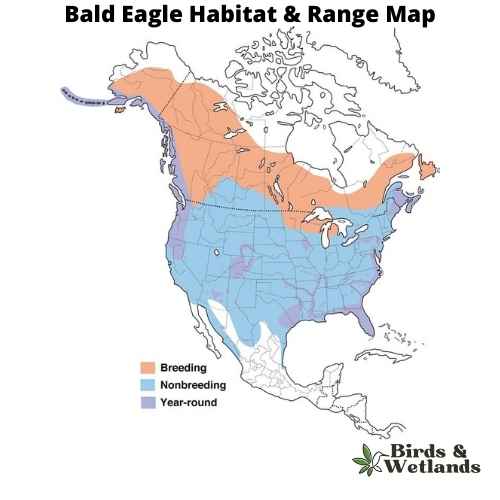
Bald Eagle Sound
Scientific Name: Haliaeetus leucocephalus
Length: 28–40 in
Wingspan: 5 ft 11 in and 7 ft 7 in
Weight: 6.6 -13.9 lb
The Bald Eagle, primarily found in Canada and Alaska, is instantly identifiable by its white head, dark brown body, yellow beak, and a piercing cry. Its sharp, orange-yellow eyes aid in efficient night hunting.
Predominantly residing in North America, occasionally venturing into Asia and Europe, it thrives near water bodies. It perches atop trees, providing a bird’s-eye view of its prey. It feeds on fish, carrion, small mammals like rabbits and squirrels, and reptiles. Hunting involves a swift downward swoop to seize the prey, carrying it back to the nest.
Bald Eagles are monogamous, forming lifelong pairings. They construct vast nests from sticks, lined with moss or grasses. They typically lay 1-3 eggs annually, which hatch around 35 days later. The fledglings leave the nest roughly 6 weeks after hatching, but continue to rely on their parents for nourishment for a further 5-6 months, until they become proficient hunters.
Golden Eagle (Aquila chrysaetos)
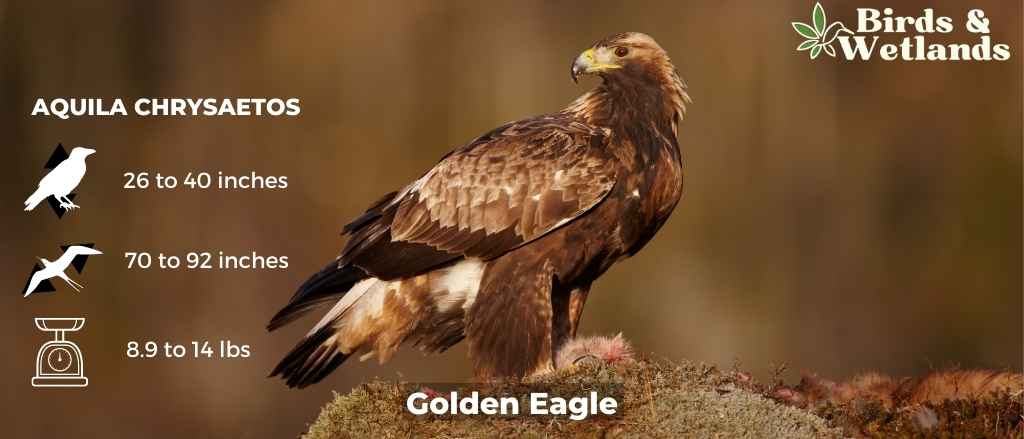
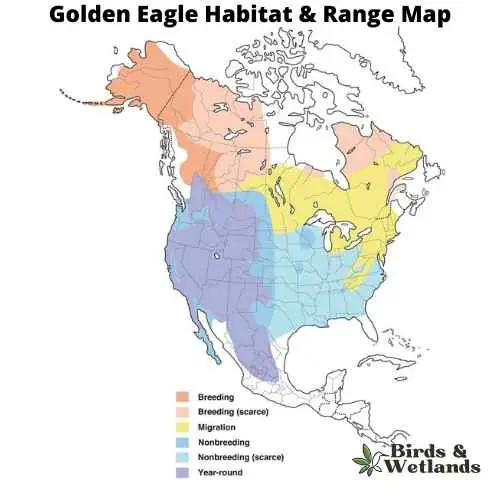
Golden Eagle Sound
Scientific Name:Aquila chrysaetos
Length: 26 to 40 in
Wingspan: 5 ft 11 in to 7 ft 8 in
Weight: 8.9 and 14.0 lb
The Golden Eagle is a large bird of prey known for its strength, speed, and hunting prowess.
Adult Golden Eagles are large birds, and are named for the golden-brown plumage on their heads and necks, which contrasts with their darker brown body feathers. Their eyes, legs, and bill are all yellow.
These eagles prefer open, rugged terrain, including mountains, hills, grasslands, and deserts. They are most often found in areas that provide good opportunities for soaring and hunting.
Golden Eagles have a varied diet but primarily prey on small to medium-sized mammals such as rabbits, hares, and ground squirrels. They are also capable of taking larger prey, like young deer or livestock, but these are not typically part of their diet.
Golden Eagles build large nests or eyries, usually on cliffs or in tall trees. The nests are often reused and added to each year, becoming enormous structures over time. The female typically lays 1 to 4 eggs, which both parents incubate.
Falcons
Falcons are not as large as eagles. However, they are some of the fastest birds in the air. Some species of falcon can fly at up to speeds of 200 miles per hour. Falcons’ wings are tapered and, unlike other birds, they do not build their own nests.
The birding practice of falconry is a very popular one today. This is the practice of using trained falcons to hunt and whilst attacks are very rare, falcons will attack humans if they feel threatened.
Peregrine Falcon (Falco peregrinus)

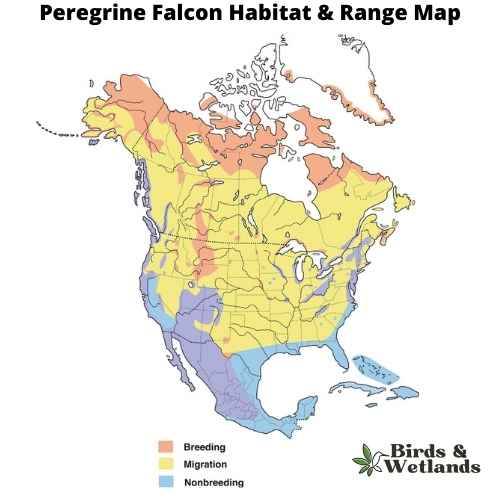
Peregrine Falcon Sound
Scientific Name: Falco peregrinus
Length: 14.2-19.3 in
Wingspan: 39.4-43.3 in
Weight: 530-1600 g
Known for its blue-gray plumage and unique cheek bars, the Peregrine Falcon stands as a beacon of power and swiftness. Despite its modest size, it reigns as the world’s fastest creature, reaching staggering speeds up to 240 mph during hunting dives.
Its diet mainly includes birds, occasionally bats, caught in an enthralling aerial display of agility and precision. Adapting to diverse habitats, this bird graces every continent except Antarctica, finding home in environments from city skyscrapers to towering cliffs.
Peregrine Falcons, monogamous in nature, often pair for life, expressing their bonds through complex courtship flights filled with intricate aerial maneuvers. They construct simple scrape nests on high ledges, often without adding materials.
Their parenting duties are shared, from egg incubation to feeding and caring for the chicks, ensuring their offspring are ready to take on the skies in their own time.
American Kestrel (Falco sparverius)
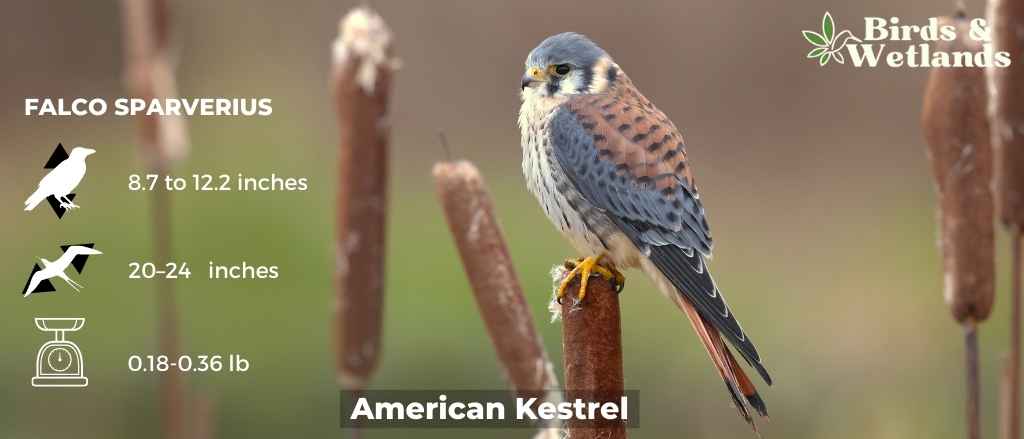

American Kestrel Sound
Scientific Name: Falco sparverius
Length: 8.7 to 12.2 in
Wingspan: 20–24 in
Weight: 3.0–5.8 oz
The American Kestrel, often recognized as the smallest and most brightly colored falcon in North America, exhibits a stunning array of rufous, blue and gray hues in its plumage. This bird, ranging in size from a mere 22 to 31 cm, carries distinct black facial markings that contrast with its white cheeks and has blue gray wings. Despite its small stature, the American Kestrel is a formidable predator, employing a unique hunting strategy that involves hovering at a height before swooping down on prey, primarily consisting of insects, small mammals, and occasionally small birds.
Residing predominantly in North and South America, the American Kestrel exhibits a preference for open habitats such as meadows, grasslands, and deserts. They are also found in both urban and suburban environments, nesting in cavities in trees, cliffs, buildings, and other structures. Kestrels are monogamous, with both sexes participating in the courtship displays that involve aerial acrobatics and feeding rituals. Nesting duties are a shared responsibility, with the male initially scouting for suitable locations and the female making the final selection. Both parents contribute to the incubation of the eggs and care of the young, ensuring the perpetuation of this captivating species.
Merlin (Falco columbarius)

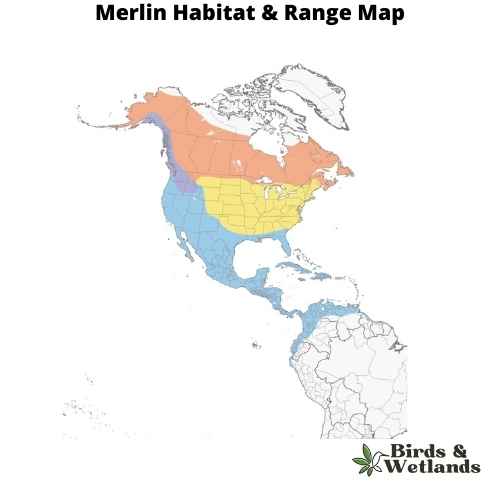
Merlin Sound
Scientific Name: Falco columbarius
Length: 9.4–13.0 in
Wingspan: 20–29 in
Weight: 5.8 – 8.1 ozz
The Merlin is a small, robust falcon known for its blue-gray or dark brown upperparts and thinly streaked, buff to orange underparts. Unlike other falcons, it has faint facial markings, offering a more uniform look.
This compact bird, renowned for its hunting prowess, chases down small birds in mid-air, exemplifying its impressive speed and agility.
Residing across northern North America, Europe, and Asia, the Merlin prefers open or semi-open landscapes. Rather than constructing their own nests, they tend to reuse old crow or raptor nests, or choose to nest on the ground in open habitats.
During courtship, males perform elaborate aerial displays. Both parents share egg incubation duties, with the male also responsible for feeding the family, reflecting the Merlin’s fascinating role in the biodiversity of its ecosystems.
Prairie Falcon (Falco mexicanus)
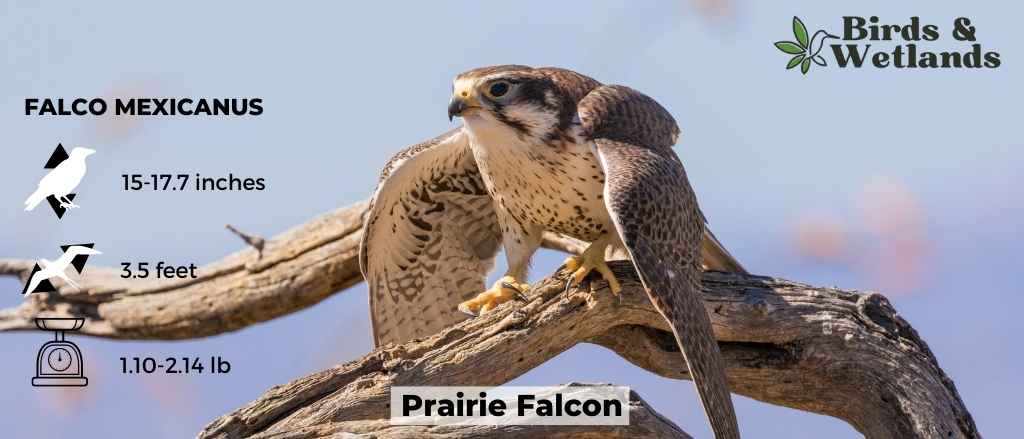
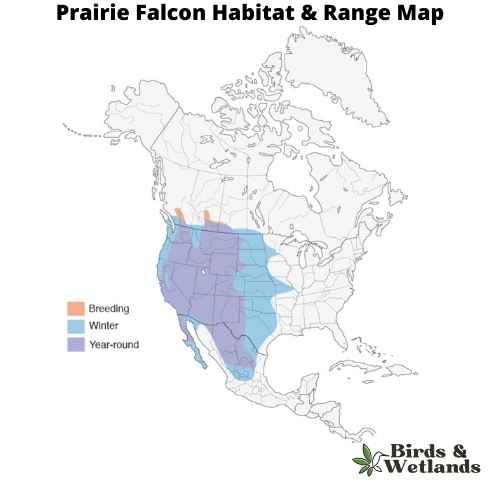
Prairie Falcon Sound
Scientific Name: Falco mexicanus
Length: 15 in – 17.7 in
Wingspan: 3.5 feet
Weight: 1.1 to 2.1 lbs
The Prairie Falcon, is a large falcon species that inhabits the open landscapes of North America, particularly in the western regions of the continent. Known for its agility and speed, this bird of prey is a skilled hunter and a master of flight.
Prairie Falcons sport a distinct color pattern with a pale, buffy brown body, contrasted with darker wingtips and a characteristic “mustache” mark near the eyes, a feature common to many falcons.
The Prairie Falcon’s diet primarily consists of small mammals and birds. It is known for its high-speed aerial pursuits, diving onto its prey from great heights. This agile predator often utilizes the open terrain of its habitat, making swift, low-level flights to catch prey off-guard.
Nesting for the Prairie Falcon often takes place on high cliff ledges, where it lays a clutch of 3 to 5 eggs. After hatching, the young falcons remain in the nest for up to six weeks, continuing to rely on their parents for food until they master hunting skills.
Gyrfalcon (Falco rusticolus)
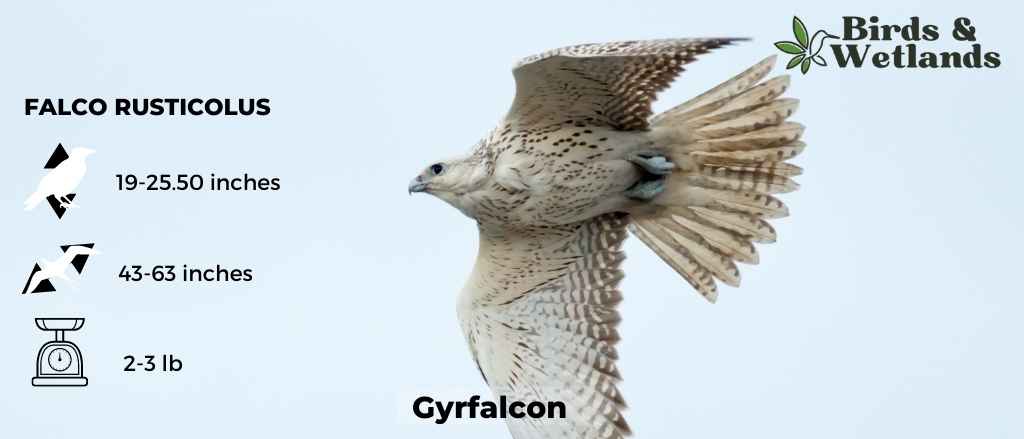
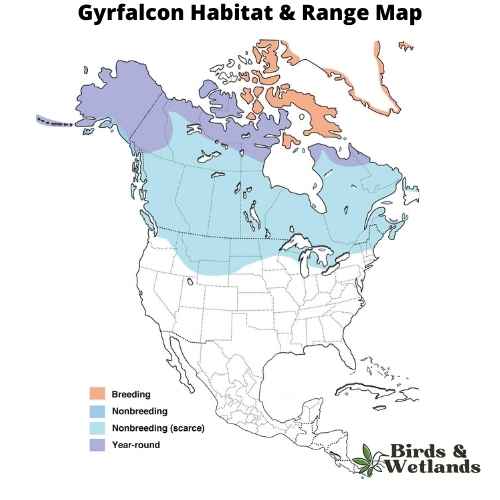
Gyrfalcon Sound
Scientific Name:Falco rusticolus
Length: 19 to 25 in
Wingspan: 43 to 63 in
Weight: 2 lb 8 oz to 3 lb 13
The Gyrfalcon is the largest of the falcon species and is renowned for its power and majestic beauty. It’s found primarily in the circumpolar regions of the Northern Hemisphere, inhabiting the arctic coasts and tundra, and sometimes venturing south during winter.
Gyrfalcons vary in color, with plumage ranging from a dark grey to a nearly pure white, but typically they possess a mix of gray and white feathers. Its broad, powerful wings enable fast and agile flight, and it has a large, strong beak and talons for hunting and feeding.
Being a bird of the Arctic, the Gyrfalcon is well-adapted to cold climates. It feeds predominantly on birds and small mammals, including ptarmigans and hares. It’s known for its striking hunting technique where it pursues and overtakes its prey in a fast horizontal chase.
Nesting typically occurs on cliff faces or other high, inaccessible spots. The female Gyrfalcon lays between 2 to 5 eggs, and both parents share in the incubation and feeding of the chicks.
The Gyrfalcon has a historical significance as well; it was considered a bird of kings and nobility, often used in falconry due to its size, power, and beauty.
Hawks
Hawks and falcons have more or less the same size. They hunt for prey in two main ways – by flying and by walking. Similar to their larger relatives, the eagles, hawks’ nests are built of sticks. However, compared to eagles, hawks lay more eggs. A single female hawk can lay up to 6 eggs and, sometimes, even more.
Red-tailed Hawk (Buteo jamaicensis)
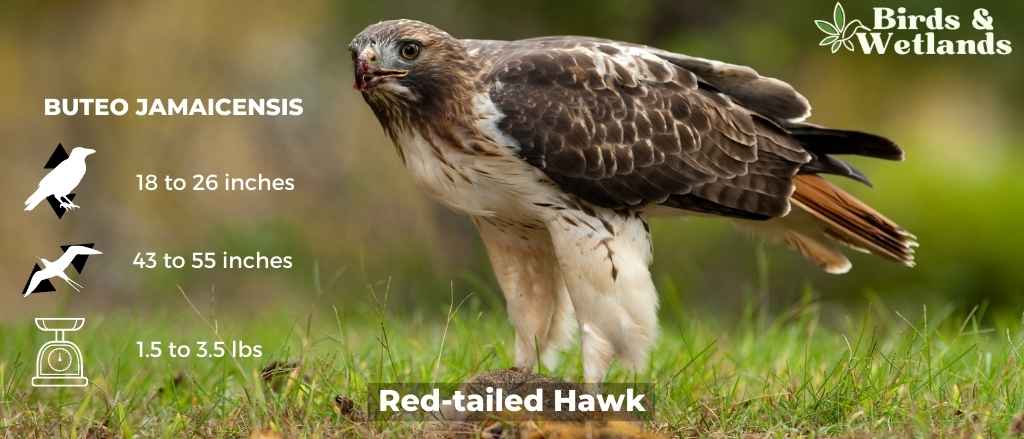
The Red-tailed Hawk is a large bird of prey that is commonly found across North America. This species is part of the genus Buteo, which is often referred to as the “true hawks,” and includes more than two dozen species of raptors.
Red-tailed Hawks have a robust size, ranging from 18 to 26 inches in length and sporting a wingspan that can exceed 4 feet. They have a broad, rounded set of wings and a short, wide red tail. This species is most easily recognized by its rich, rust-colored tail, which gives it its common name. However, juvenile hawks might not yet have this distinctive feature.
Their feathers are generally dark brown on their dorsal side (back) with a lighter, often speckled, ventral side (front). The intensity and pattern of their plumage can vary significantly based on their age and geographic location, as there are about 14 recognized subspecies of Red-tailed Hawks.
As for their diet, Red-tailed Hawks are carnivores and have a broad diet that includes rodents, ground rabbits, reptiles, and other birds. They are skilled hunters that typically sit on high perches and use their keen eyesight to spot potential prey. Once they have identified a target, they swoop down to capture it with their powerful talons.
Red-tailed Hawks mate for life and build nests high off the ground, often in tall trees or on cliff edges. Their nests are made of sticks and can be quite large. They typically lay 1-3 eggs per year, which are incubated by both parents.
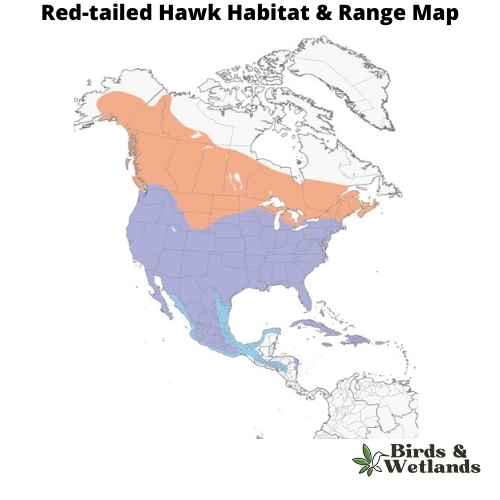
Red-tailed Hawk Sound
Sharp-shinned Hawk (Accipiter striatus)
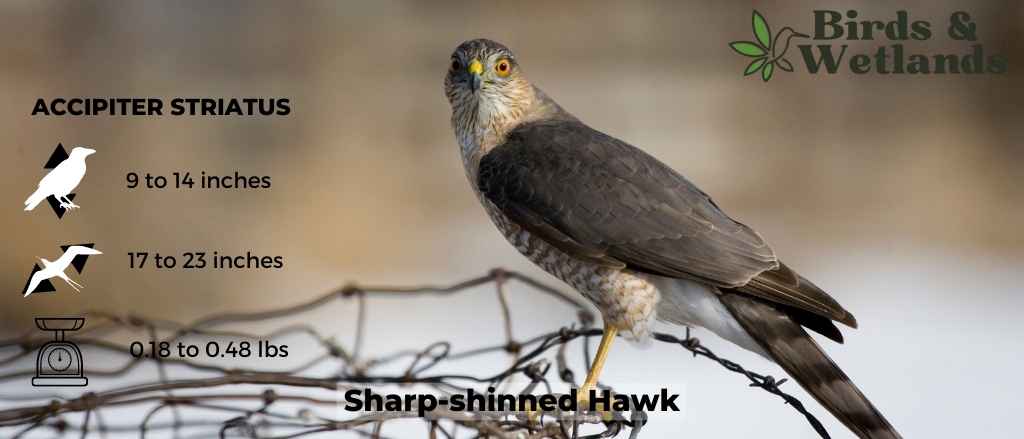
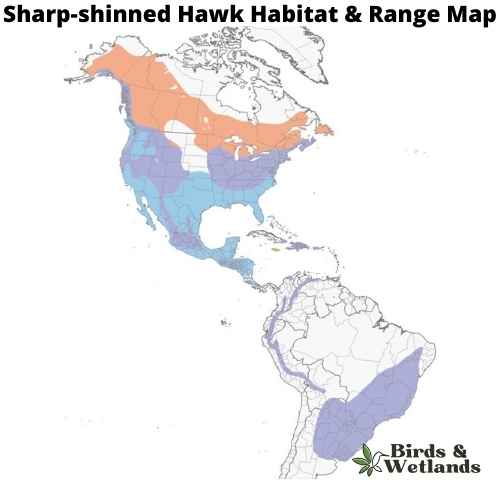
Listen:
The adult bird is brown on top and white underneath, with a dark brown band across its chest. It has short, rounded wings and a long tail that makes it look larger than it actually is. Adult sharp shinned hawks have black eyes, which are surrounded by white feathers. The female Sharp-shinned Hawk is browner than the male, who has darker brown markings on his back.
Sharp-shinned Hawks prefer open country for their habitat, including fields and meadows where they can hunt for mice and other small animals. They can be found throughout the United States but are most common in the east.
Sharp-shinned Hawks eat mostly small birds, such as sparrows and warblers, as well as small mammals such as mice and gophers. They catch prey by surprise using their incredible speed and agility, diving out of the sky at speeds up to 200 mph.
Sharp-shinned Hawks have an unusual hunting style for hawks—they prefer to catch their prey from perches above trees or telephone wires, rather than swooping down from above like most other hawks do and can often be seen hunting near bird feeders.
Cooper’s Hawk (Accipiter cooperii)

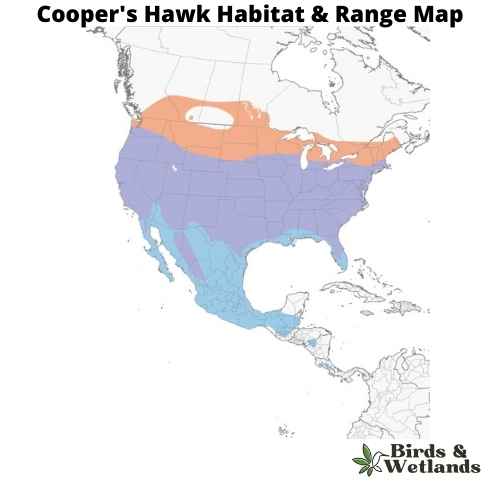
Listen:
The Cooper’s Hawk is a medium-sized bird of prey native to North America. Known for its agility and speed, it is part of the Accipitridae hawk species, which also includes other hawks, eagles, and kites.
Cooper’s Hawks are typically about 14 to 20 inches in length, with a wingspan ranging from 27 to 36 inches. They are known for their distinctive long, rounded tails and short, rounded wings. They have a steely blue gray top, with rusty bars on their underparts and thick, dark bands on their tails.
The Cooper’s Hawk is a skilled predator, primarily hunting birds and small mammals. They are adept at hunting in both dense forests and open areas, often catching prey mid-air in high-speed pursuits. They have also been known to visit the backyard bird feeder, not for the seed, but to prey on the smaller birds that gather there.
Cooper’s Hawks often build nests in dense tree canopies where they are well concealed. The female usually lays 3 to 5 eggs, and both parents share incubation duties. The young hawks fledge after about a month but will stay close to the nest, relying on their parents for food as they learn to hunt.
Northern Goshawk (Accipiter gentilis)
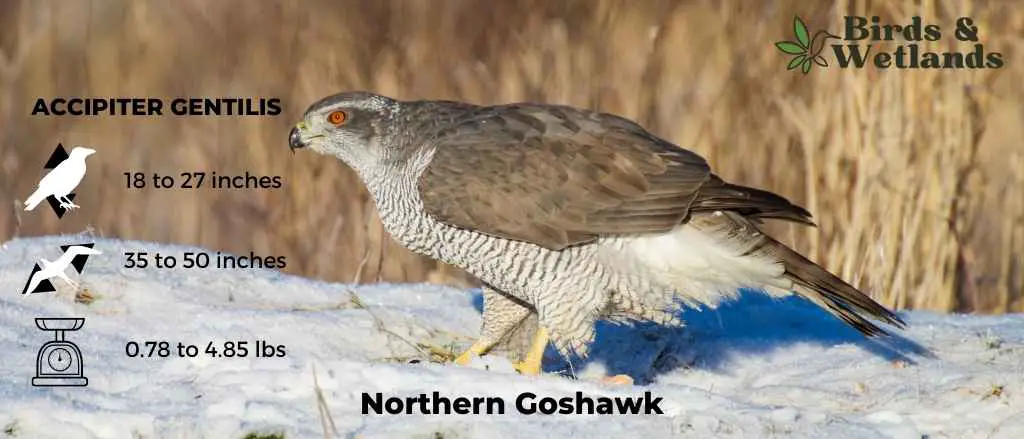
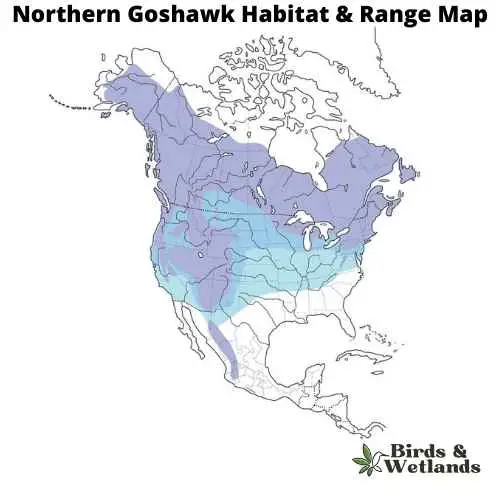
Listen:
The Northern Goshawk is a medium-sized hawk that is found in North America, Europe and Asia. It has brown eyes, a large sharp beak, and dark brown plumage on its upperparts and head, with white underparts that are spotted with brown barring. Its tail feathers are grayish-black with a dark band near the tip.
Northern goshawks eat squirrels, rabbits, grouse, woodchucks and other small mammals like voles or mice (which they often eat whole). They will also take larger prey such as deer fawns or even adult deer if they have no other choice. They have broad wings with long feathers that allow them to glide through the air when they catch their prey. They also have an excellent sense of smell which helps them locate their food source.
The Northern Goshawk builds its nest in a tree cavity or on a ledge, usually on the edge of an open area so it can easily see prey below. The female lays 3 to 5 eggs over two days and incubates them for 28 to 30 days while the male brings food to her every few hours until they hatch. The young fledge after about 6 weeks and leave the nest when they are about 10 weeks old.
Broad-winged Hawk (Buteo platypterus)
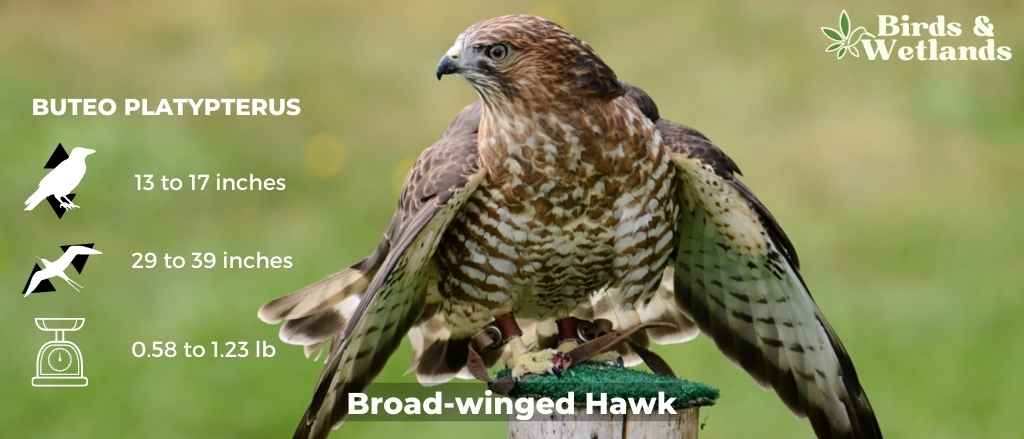
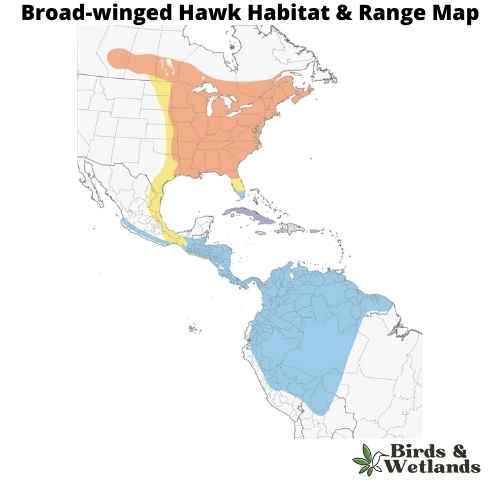
Broad-winged Hawk Sound
The Broad-winged Hawk holds a commanding presence as one of the largest hawks in the world, known for its broad wings. Its formidable size is a testament to its prowess as a bird of prey, effortlessly navigating the open skies in search of food.
Their distinctive appearance sets them apart. The adults exhibit a striking black and white pattern, complemented by a rusty breast and buff underparts and brown wings. In contrast, juveniles are adorned with a brown plumage, marked by pale edges on their feathers, adding to their distinctive youthful charm.
These hawks are most commonly found in open areas, such as farmlands or grasslands interspersed with scattered trees, which provide optimal conditions for when hawks hunt.
When it comes to their diet, Broad-winged Hawks feed on small rodents like mice, rats, squirrels, rabbits, and voles. Broad winged hawks breed during the spring and summer months then migrate to central and south America.
Swainson’s Hawk (Buteo swainsoni)
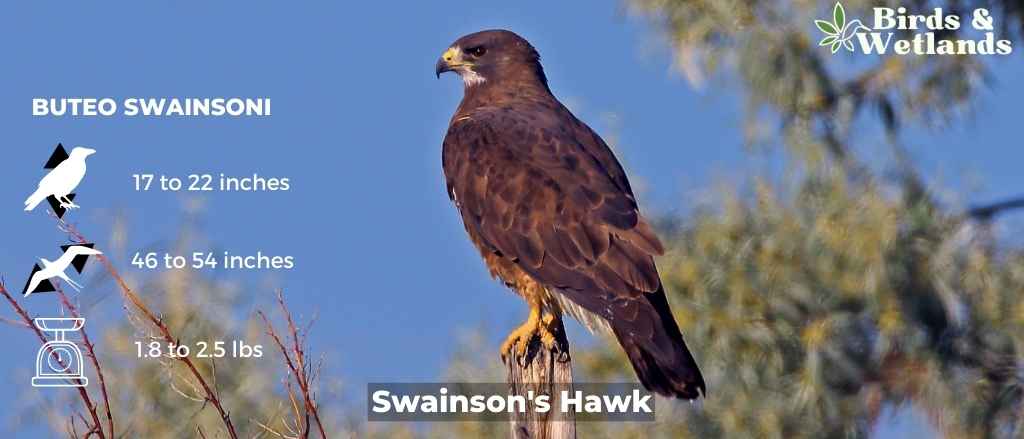
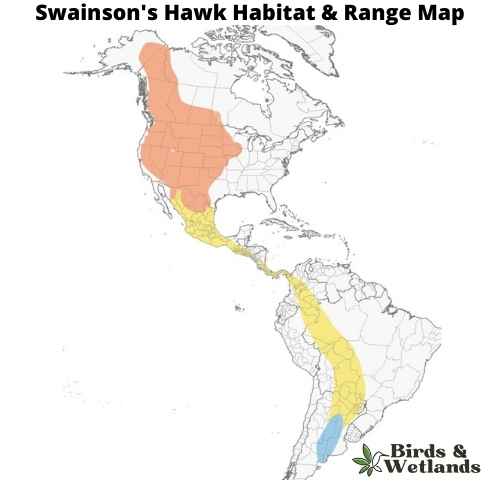
Listen: Swainson’s Hawk
Swainson’s Hawk is a medium-sized hawk that is found in North America and South America, Scientific Name: Buteo swainsoni.
The bird has a blue-gray plumage with a dark brown back, wings, and tail. It also has a white chest and belly. The beak and feet are black, but the eyes are yellow. They are often confused with Cooper’s Hawk because of similar coloring, but Swainson’s Hawks have wider tails and longer wings than their cousin species.
These birds eat small rodents such as gophers and mice. They also eat insects like grasshoppers and crickets during the summer months when they’re plentiful. They sometimes steal prey from other birds of prey such as Northern Harriers who hunt the same prey.
Swainson’s Hawks build nests on rocky cliffs near water sources where they can find food easily. They lay three to five eggs that hatch after about two months into fluffy brown baby hawks who leave the nest after about three weeks (or when they’re big enough).
Rough-legged Hawk (Buteo lagopus)
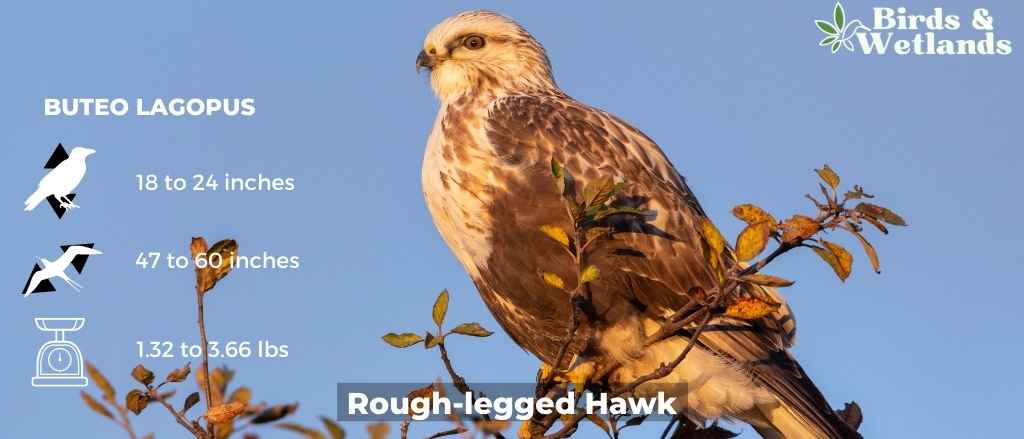
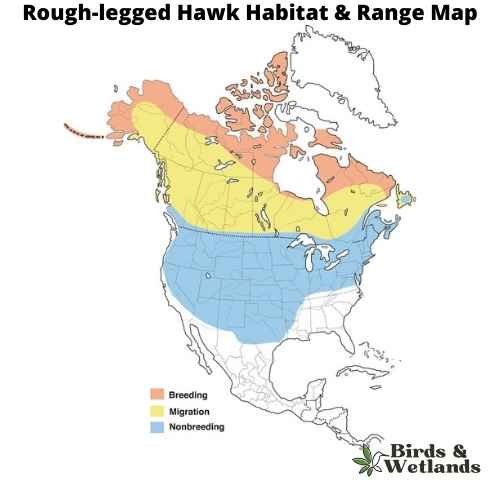
Rough-legged Hawk Sound
The Rough-legged Hawk is a large, raptor that is native to North America. It is also known as the American Rough-legged Hawk. Scientific Name: Buteo lagopus
The Rough-legged Hawk is a medium-sized hawk with a distinctive appearance, with dark brown feathers on its back and light brown feathers on its underside and broad thin wings. The hawk’s legs are also covered in dark feathers, which help to distinguish it from other species of hawk. The tail is barred with black and white. They have yellow eyes and dark feet.
Rough-legged Hawks hunt from above ground level, swooping down to catch its prey in its talons. When hunting for food, they prefer to eat small mammals such as squirrels and rabbits but will also eat birds if there aren’t any small mammals available. Although they eat a variety of small animals including birds, rodents, bats and reptiles, they rely heavily on fish for food during breeding season because it provides them with protein and calcium needed to produce eggs.
Ferruginous Hawk (Buteo regalis)
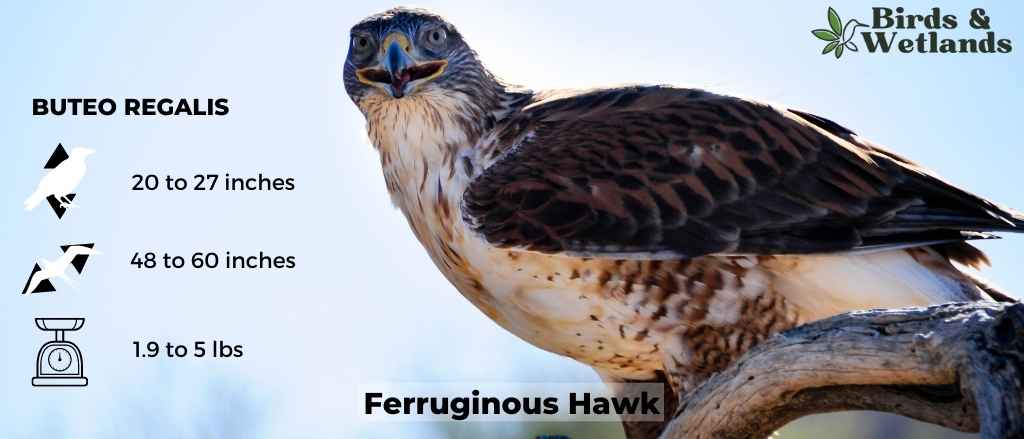
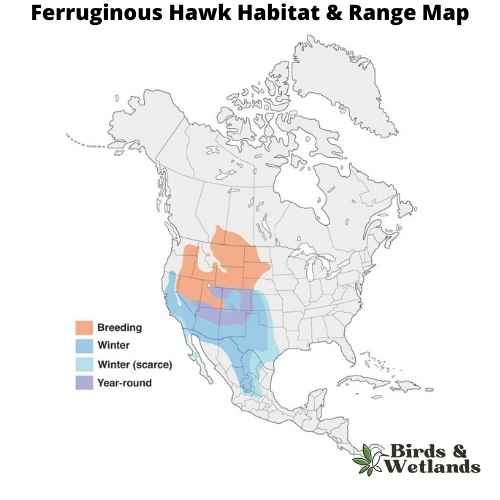
Ferruginous Hawk Sound
Scientific Name: Buteo regalis
Length: 20 to 27 in
Wingspan: 48 to 60 in
Weight: 32.0 to 80.0 oz
The Ferruginous Hawkis the largest hawk species native to North America. Known for its distinctive coloration and impressive size, this bird of prey predominantly inhabits the open landscapes of the western United States and parts of Canada.
Ferruginous Hawks are notable for their “ferruginous” or rust-colored back and shoulders, which contrasts sharply with the bird’s white underside. The hawk also has broad, rounded wings and a large, gape-mouthed beak. Ferruginous hawks exhibit dark morph and light morphs. Dark morphs have dark brown plumage, while light morphs display lighter, reddish-brown plumage. Morphs vary geographically.
Primarily feeding on small to medium sized mammals like rabbits and prairie dogs, the Ferruginous Hawk is an agile hunter, often seen soaring high above the ground or perched prominently while scanning for prey. It occasionally feeds on birds, reptiles, and insects as well.
Nesting for Ferruginous Hawks typically occurs on cliffs, hillsides, or large trees. The female lays between 2 to 5 eggs, and both parents share in the incubation and rearing of the chicks. The Ferruginous Hawk is a relatively solitary bird outside of the breeding season, and its call is a loud, high-pitched scream, often heard during courtship or near the nest.
Northern Harrier (Circus hudsonius)
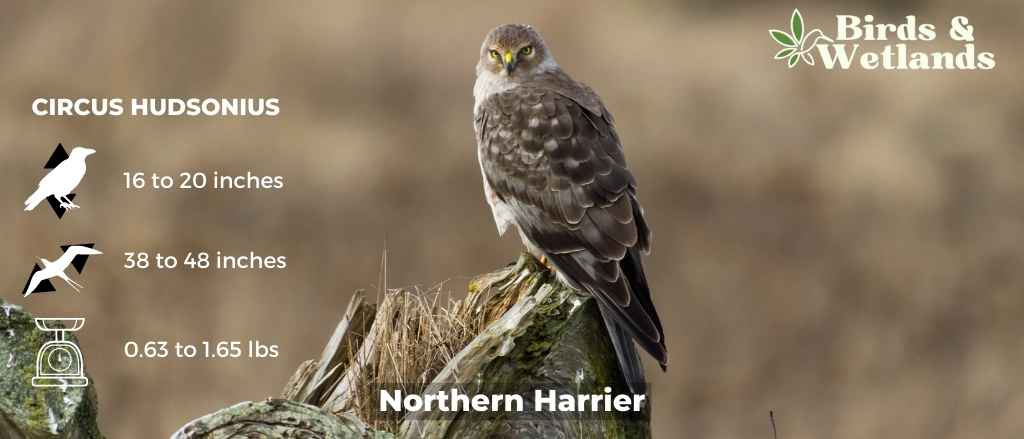
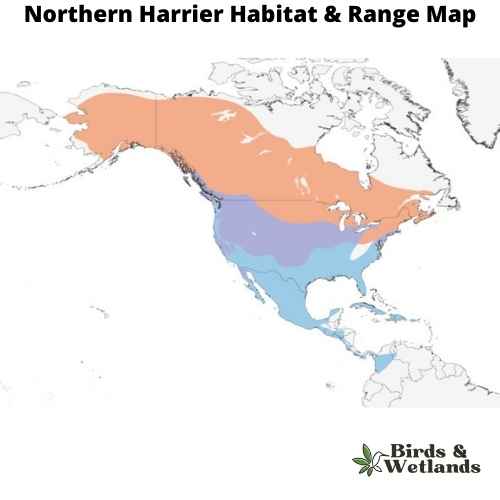
Listen:
The Northern Harrier is a medium-sized, slender hawk.
Adult birds are gray above, with pale bars on the wing feathers and white markings on the underwings and a white rump patch. The breast is barred with black and white, and the belly is streaked with brown.
They prefer open areas, such as grasslands and marshes, but can be found in almost any open habitat except dense woods.
Northern Harriers are opportunistic hunters that feed on small mammals such as mice, voles and rabbits as well as birds including quail, grouse and ducks. They hunt by flying low over open spaces such as fields or marshes.
Northern harrier nests on the ground in lowlands or hillsides near water bodies. It lays two to four eggs which hatch after 24 days of incubation by both parents. The chicks fledge after 30 days of hatching and remain dependent on their parents for another three weeks during which they learn how to fly.
Eurasian Marsh-Harrier (Circus aeruginosus)
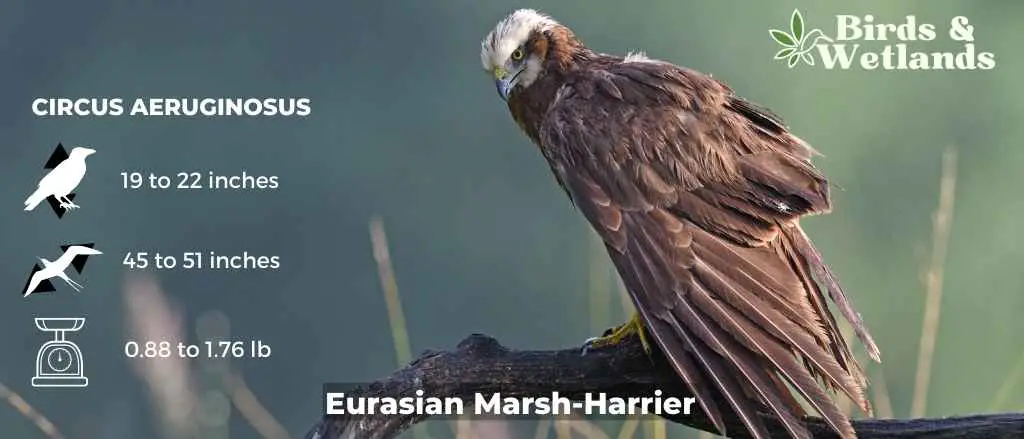
The Eurasian Marsh-Harrier, also known as the Marsh Harrier, is a species of bird of prey. Their name comes from their unique hunting technique known as “marsh-hawking” where they fly low over water surfaces while searching for prey
- Scientific Name: Circus aeruginosus
- Length: 48 to 56 cm (19 to 22 in)
- Wingspan: 115 to 130 cm (45 to 51 in)
- Weight: Male: 400 to 650 g (14 to 23 oz)/Female: 550 to 800 g (19 to 28 oz)
Eurasian Marsh-Harrier Description
The Eurasian Marsh-Harrier has long legs, which help it walk gracefully through marshy or boggy areas. It has a black head with white cheeks and a grey body with brown wings and tail. They have yellow eyes and red legs with yellow feet.
Eurasian Marsh-Harrier Sound
Eurasian Marsh-Harrier Habitat & Range
They are found in Europe, Central Asia, Siberia and Mongolia, but are most common in the plains of Southern Europe. Its habitat includes rivers, lakes, marshes, rice fields and reedbeds.

Eurasian Marsh-Harrier Diet
They are nocturnal hunters who prey on small birds such as quails, other gamebirds and waterfowl such as ducks or geese. Their diet consists mainly of small birds and mammals such as mice, voles, shrews, frogs and lizards but they will also eat insects if necessary. They may also catch fish if they come across them in shallow water during migration or wintering periods.
Eurasian Marsh-Harrier Nesting
The breeding season lasts from April to July with one brood per year produced by both sexes; however females usually produce only one egg per clutch while males can produce up to three eggs per clutch leading to reduced reproductive success for females compared with males.
Sharp-shinned Hawk (Accipiter striatus)


Listen:
The adult bird is brown on top and white underneath, with a dark brown band across its chest. It has short, rounded wings and a long tail that makes it look larger than it actually is. Adult sharp shinned hawks have black eyes, which are surrounded by white feathers. The female Sharp-shinned Hawk is browner than the male, who has darker brown markings on his back.
Sharp-shinned Hawks prefer open country for their habitat, including fields and meadows where they can hunt for mice and other small animals. They can be found throughout the United States but are most common in the east.
Sharp-shinned Hawks eat mostly small birds, such as sparrows and warblers, as well as small mammals such as mice and gophers. They catch prey by surprise using their incredible speed and agility, diving out of the sky at speeds up to 200 mph.
Sharp-shinned Hawks have an unusual hunting style for hawks—they prefer to catch their prey from perches above trees or telephone wires, rather than swooping down from above like most other hawks do and can often be seen hunting near bird feeders.
Cooper’s Hawk (Accipiter cooperii)


Listen:
The Cooper’s Hawk is a medium-sized bird of prey native to North America. Known for its agility and speed, it is part of the Accipitridae hawk species, which also includes other hawks, eagles, and kites.
Cooper’s Hawks are typically about 14 to 20 inches in length, with a wingspan ranging from 27 to 36 inches. They are known for their distinctive long, rounded tails and short, rounded wings. They have a steely blue gray top, with rusty bars on their underparts and thick, dark bands on their tails.
The Cooper’s Hawk is a skilled predator, primarily hunting birds and small mammals. They are adept at hunting in both dense forests and open areas, often catching prey mid-air in high-speed pursuits. They have also been known to visit the backyard bird feeder, not for the seed, but to prey on the smaller birds that gather there.
Cooper’s Hawks often build nests in dense tree canopies where they are well concealed. The female usually lays 3 to 5 eggs, and both parents share incubation duties. The young hawks fledge after about a month but will stay close to the nest, relying on their parents for food as they learn to hunt.
Northern Goshawk (Accipiter gentilis)


Listen:
The Northern Goshawk is a medium-sized hawk that is found in North America, Europe and Asia. It has brown eyes, a large sharp beak, and dark brown plumage on its upperparts and head, with white underparts that are spotted with brown barring. Its tail feathers are grayish-black with a dark band near the tip.
Northern goshawks eat squirrels, rabbits, grouse, woodchucks and other small mammals like voles or mice (which they often eat whole). They will also take larger prey such as deer fawns or even adult deer if they have no other choice. They have broad wings with long feathers that allow them to glide through the air when they catch their prey. They also have an excellent sense of smell which helps them locate their food source.
The Northern Goshawk builds its nest in a tree cavity or on a ledge, usually on the edge of an open area so it can easily see prey below. The female lays 3 to 5 eggs over two days and incubates them for 28 to 30 days while the male brings food to her every few hours until they hatch. The young fledge after about 6 weeks and leave the nest when they are about 10 weeks old.
Broad-winged Hawk (Buteo platypterus)


Broad-winged Hawk Sound
The Broad-winged Hawk holds a commanding presence as one of the largest hawks in the world, known for its broad wings. Its formidable size is a testament to its prowess as a bird of prey, effortlessly navigating the open skies in search of food.
Their distinctive appearance sets them apart. The adults exhibit a striking black and white pattern, complemented by a rusty breast and buff underparts and brown wings. In contrast, juveniles are adorned with a brown plumage, marked by pale edges on their feathers, adding to their distinctive youthful charm.
These hawks are most commonly found in open areas, such as farmlands or grasslands interspersed with scattered trees, which provide optimal conditions for when hawks hunt.
When it comes to their diet, Broad-winged Hawks feed on small rodents like mice, rats, squirrels, rabbits, and voles. Broad winged hawks breed during the spring and summer months then migrate to central and south America.
Kites
Compared to the other birds in this list, kites are not as powerful and aggressive. Their main foods are snails, insects and small animals. Kites are also scavengers. They feed on dead animals and garbage.
Mississippi Kite (Ictinia mississippiensis)
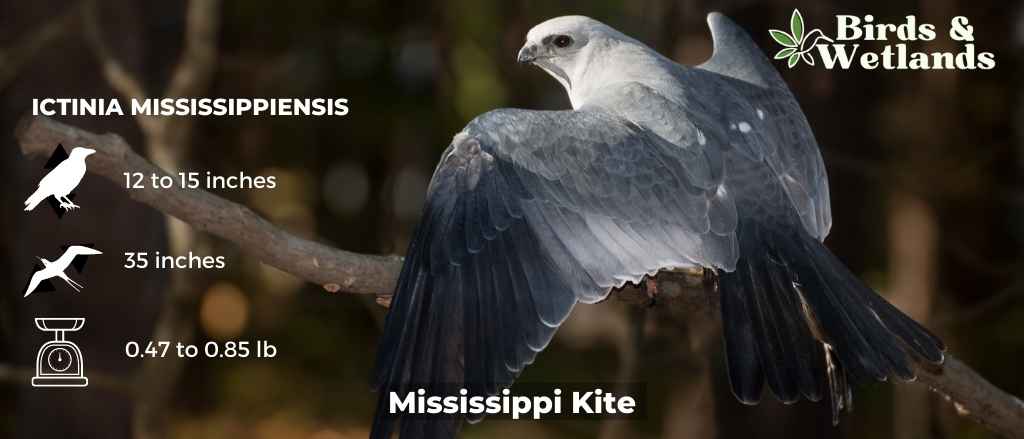
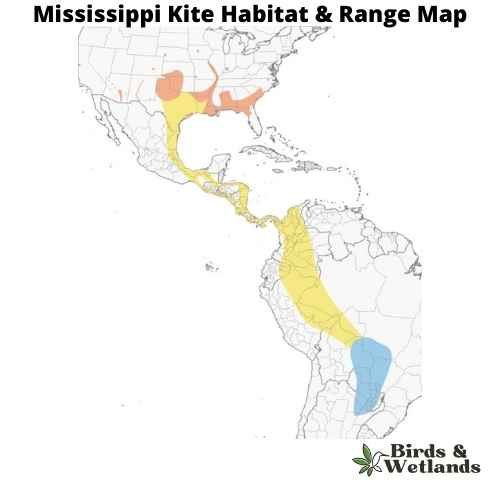
Mississippi Kite Sound
Scientific Name: Ictinia mississippiensis
Length: 12 to 15 inches (30–37 cm)
Wingspan: 3 feet (91 cm)
Weight: 214 to 388 grams (7.6–13.7 oz)
The Mississippi kite is a medium-sized bird of prey native to North America. It has a white belly and chest, with brown wings and tail and pointed wings. They have a black mask on their face, and the males have blue markings on their wings.
The Mississippi kites habitat is open grassland, including prairies, pastures, and meadows. It can also be found in wetlands such as marshes and swamps. It prefers warmer climates but can survive in cooler regions if there are many trees nearby that provide nesting sites.
The diet of these birds consists mostly of insects such as grasshoppers, beetles and dragonflies. They also eat small rodents that they catch while flying over fields or while perched on tall trees or telephone poles.
The Mississippis kite nest looks like a shallow bowl built with sticks, twigs and grasses. They lay between 2-5 eggs per year, which take about two weeks to hatch into chicks that fledge after two months. The breeding season for Mississippi Kites typically occurs from May to July
White-tailed Kite (Elanus leucurus)
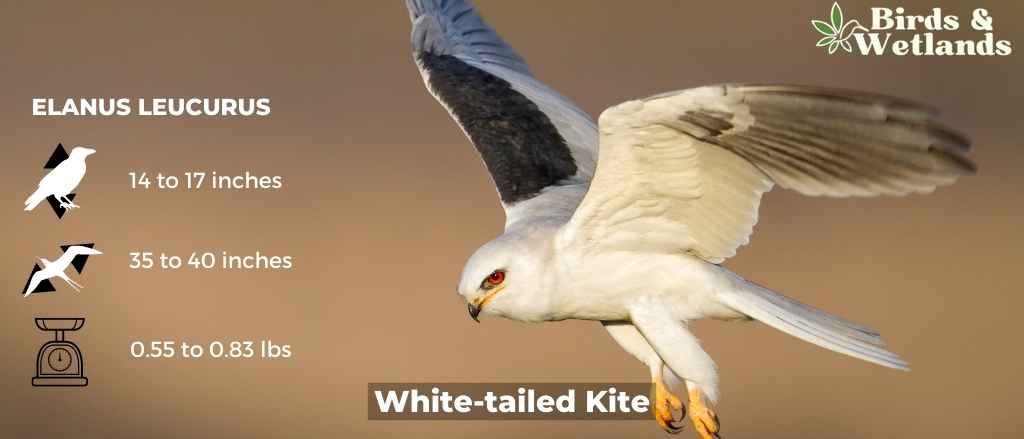

White-tailed Kite Sound
Scientific Name: Elanus leucurus
Length: 14–17 in
Wingspan: 35–40 in
Weight: (8.8–13.4 oz
The White-tailed Kite is a medium-sized bird of prey that is found throughout the Americas, from the western United States down through Central America and into South America.
White-tailed Kites have a striking appearance, with a white body, grey wings, and black shoulders. Their wings are long and pointed, giving them an elegant, buoyant flight. They get their name from their long, white tail.
They are primarily found in open grasslands, marshes, and savannas, often near bodies of water. They are known for their distinctive hunting technique, where they hover in the air before dropping onto their prey.
Their diet mainly consists of small rodents, especially voles and mice, which they hunt during the day. They are especially skilled at hunting in grassy habitats, where they can spot the movement of their prey from a distance.
White-tailed Kites are monogamous birds, with pairs building nests together in the tops of trees. They usually lay 3-5 eggs, which are incubated by both parents. After hatching, both parents take turns feeding the young.
Osprey
Ospreys are of only one species. Their main habitats are near water bodies. These hunting bodies are their main sources of food. It is common to see ospreys hovering above a water body and upon seeing prey (normally fish), they dive at a very fast speed and catch the prey.
Osprey (Pandion haliaetus)

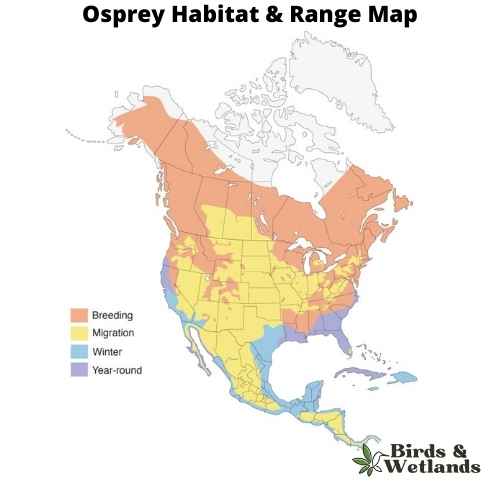
Osprey Sound
Scientific Name: Pandion haliaetus
Length: 50–66 cm (19+1⁄2–26 in)
Wingspan: 127–180 cm (50–71 in)
Weight: 0.9–2.1 kg (2 lb 0 oz – 4 lb 10 oz)
The Osprey, a fascinating bird of prey, is universally known for its exceptional hunting prowess and striking physical characteristics. Osprey are dark brown hawks on the upperparts, contrasting beautifully with the predominantly white underparts, and a distinctive dark band that stretches across the eyes towards the sides of its head.
Equipped with specialized talons and a reversible outer toe, the Osprey’s hunting strategy involves a spectacular plunge-dive into bodies of water, often emerging with a fish securely gripped in its claws.
Found on every continent except Antarctica, the Osprey is a cosmopolitan species favoring habitats near water bodies such as lakes, rivers, and coastal areas, reflecting its piscivorous diet. This bird has a diet almost exclusively of fish, making it a unique member of the raptor family and often referred to as the sea hawk or fish hawk. They locate their prey from the air, often hovering before plunging feet-first to capture a fish. When it comes to breeding, Ospreys are monogamous, often mating for life.
They construct large, bulky nests made of sticks, lined with softer materials, and prefer elevated or isolated areas such as treetops or artificial structures like utility poles. Both parents share the responsibility of incubating the eggs and rearing the chicks.
Owls
There are many different types of owls found in the United States, including the great horned owl, the snowy owl, and the barn owl.
Great Horned Owl (Bubo virginianus)

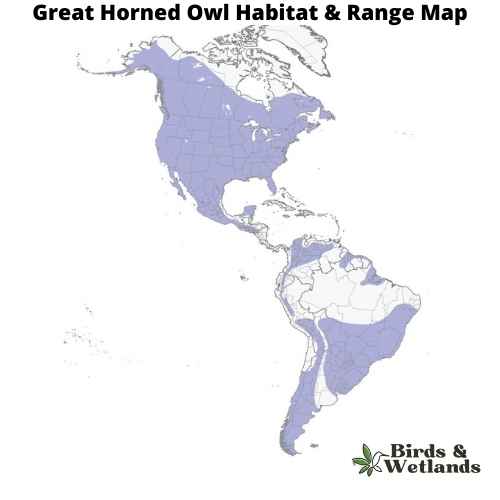
Great Horned Owl Sound
Scientific Name:Bubo virginianus
Length: 18.1-24.8 in
Wingspan: 39.8-57.1 in
Weight: 32.1-88.2 oz
The Great Horned Owl is a large owl with long wings and a large head. It’s one of the most common owls in North America.
Great Horned Owls are large, stocky birds with soft feathers that are gray to brown on their backs and white on their chests. Their faces are characterized by two black “ear” tufts, which can be raised or flattened depending on the owl’s mood. The eyes are yellow, orange, or red in color.
The habitat of the Great Horned Owl is a variety of different environments such as forests and deserts. They also live near water sources such as lakes, streams and rivers where they can hunt for fish.
The diet of the Great Horned Owl consists primarily of small mammals such as mice and rats; however they will also eat other rodents such as squirrels, rabbits and porcupines. They have been known to eat skunks too.
Snowy owl (Bubo scandiacus)
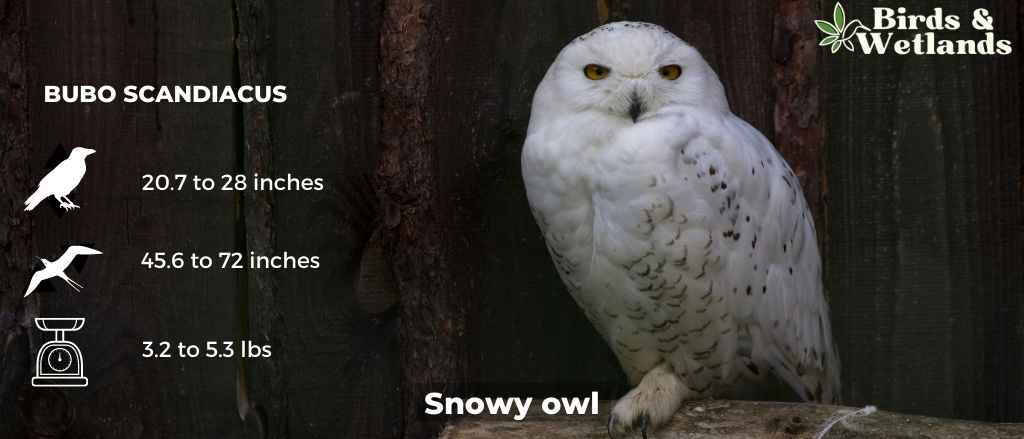
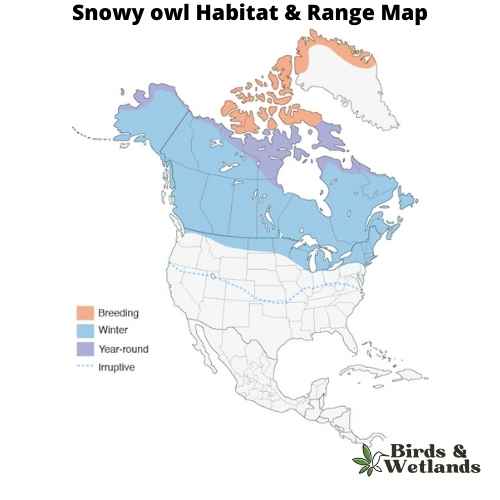
Snowy owl Sound
Scientific Name: Bubo scandiacus
Length: 20.7 to 28 in
Wingspan: 3 ft 10 in to 6 ft 0 in
Weight: 3.2lb to 5.3lb
The Snowy Owl, is of the most well-known species of owls, the Snowy Owl is renowned for its striking appearance and adaptations to its extreme environment.
Snowy Owls are medium sized birds that possess a rounded head, yellow eyes, and a black beak. The most distinctive feature of the Snowy Owl is its white plumage, which provides effective camouflage in its snowy habitat. Male Snowy Owls are often almost completely white, while females and younger owls have more extensive dark barring on their plumage.
Unlike many owl species, Snowy Owls are primarily diurnal, which means they are active during the day. This is an adaptation to life in the Arctic, where there can be 24 hours of daylight in the summer. Their diet mainly consists of small mammals, particularly lemmings, but they are known to eat a variety of animals including birds, fish, and even carrion when necessary.
Snowy Owls nest on the ground, usually on a mound or boulder. Their breeding success is closely tied to the availability of food, and in good years a single pair of owls can raise a large brood of chicks.
Northern Saw-whet Owl (Aegolius acadicus)
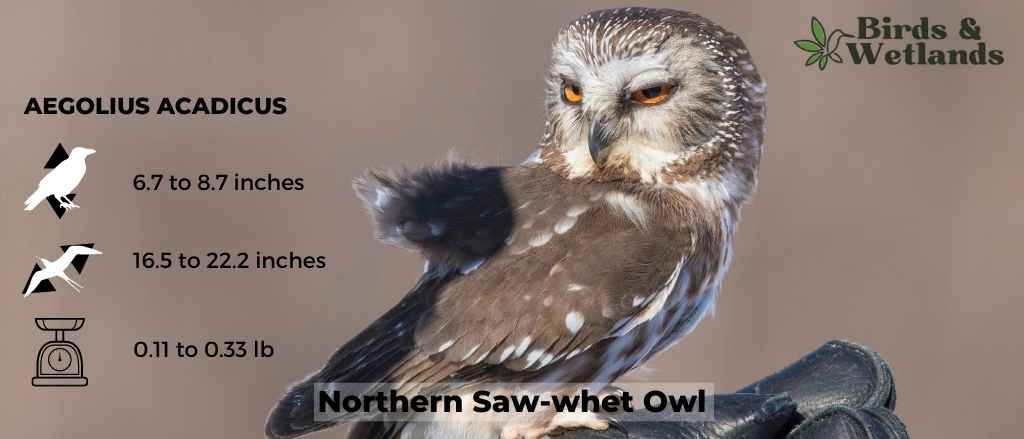
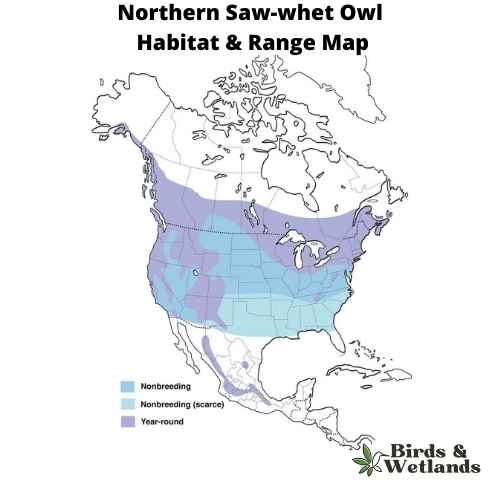
Northern Saw-whet Owl Sound
Scientific Name: Aegolius acadicus
Length: 17–22 cm (6.7–8.7 in)
Wingspan: 42–56.3 cm (16.5–22.2 in)
Weight: 54 to 151 g (1.9 to 5.3 oz)
The Northern Saw-whet Owl is a tiny, speckled gray owl and it’s one of the smallest owls in North America. It’s also known as the Little Owl or Wood Owl in some areas.
Northern Saw-whet Owls have dark brown eyes, white eyebrows, and yellow beak. It has brownish-grey feathers that are spotted with white. The owl’s legs are covered in feathers and appear nearly invisible when the bird is perched on a branch or tree.
In the winter they migrate south to warmer climates. They prefer to live in dense coniferous forest with large trees but will occasionally nest in shrubs or other vegetation that can protect them from predators.
The Northern Saw-whet Owl eats mice and voles (small rodents), small birds, frogs, salamanders, moles and shrews, but unlike most owls they chop their prey up and spread over a few meals. They will also eat insects like beetles and grasshoppers if they are available. It hunts from a perch at night using its excellent hearing to locate prey items within about 30 feet (9 meters) of its nest.
These owls nest in tree cavities usually located close to water sources such as lakes or rivers where they can find their food source (insects). They lay 2-4 eggs at one time which incubate for about 30 days before hatching.
Eastern Screech-Owl (Megascops asio)
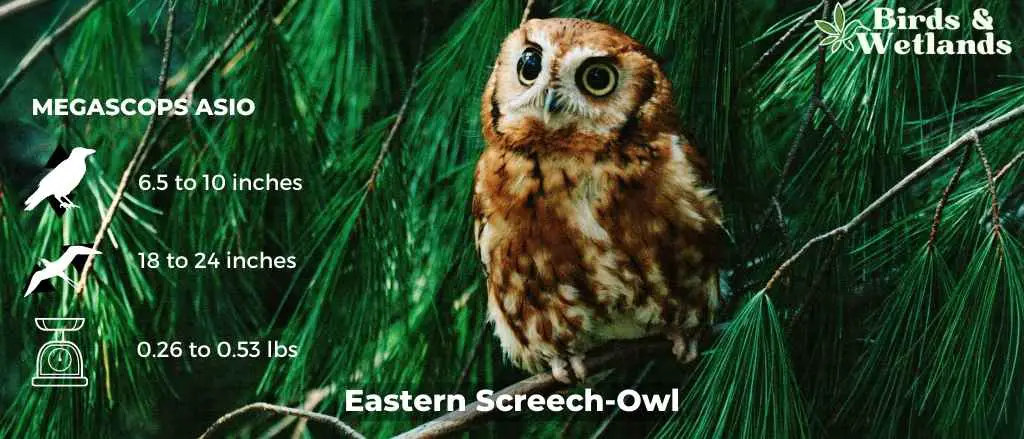
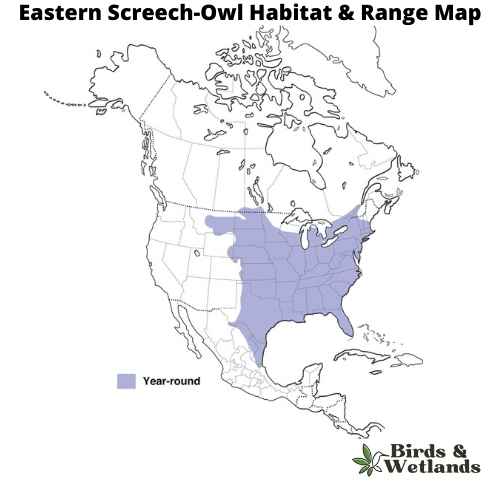
Eastern Screech-Owl Sound
Scientific Name: Megascops asio
Length: 6 to 10 in
Wingspan: 8 to 24 in
Weight: 4 – 8.5 oz
The Eastern Screech-Owl is a small owl species native to most wooded environments of the eastern half of North America, from the Canadian provinces to Florida and Texas.
Eastern Screech-Owls are relatively small and exhibit a complex pattern of gray or reddish-brown coloration, which provides excellent camouflage against tree bark.
These owls are known for their distinctive call, which is often described as a haunting trill or a whinny-like sound. Despite their name, they do not actually produce a “screech.”
Eastern Screech-Owls feed on a variety of prey, ranging from small mammals and birds to insects and even earthworms. It is primarily nocturnal, hunting at night from a low perch and swooping down onto prey.
Eastern Screech-Owls nest in tree cavities or abandoned woodpecker nests, but they readily adapt to nesting boxes where natural cavities are not available. They typically lay between 2 to 6 eggs, which are incubated primarily by the female.
Western Screech-Owl (Western Screech-Owl)
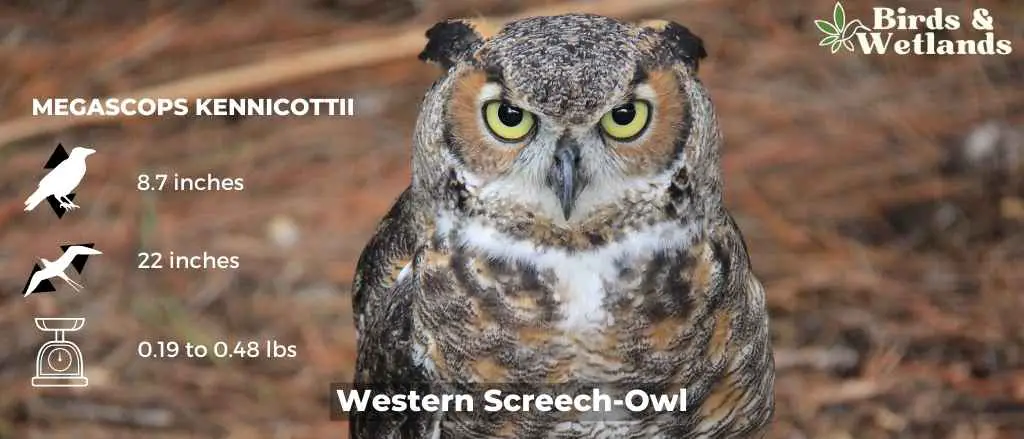
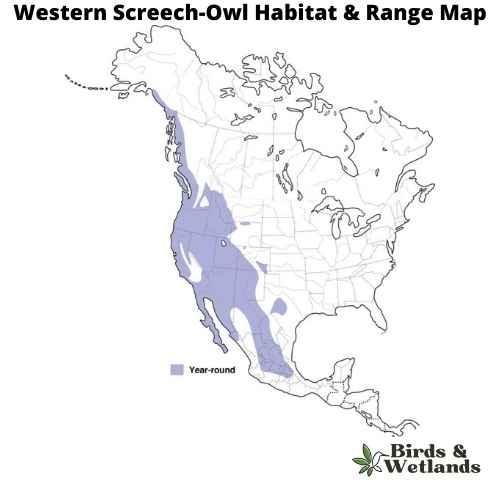
Western Screech-Owl Sound
Scientific Name: Megascops kennicottii
Length: 22 cm (8.7 in)
Wingspan: 55 cm (22 in)n
Weight: 88 to 220 g (3.1 to 7.8 oz)
The Western Screech-Owl, or Megascops kennicottii, is a small species of owl native to North and Central America. Western Screech-Owls are nocturnal predators, and its diet primarily consists of small mammals, birds, insects, and occasionally fish.
This owl is medium-sized compared to other screech-owls. It has a compact, stocky body, and is often recognized by its large head with yellow eyes surrounded by greyish-brown facial disks. The plumage is generally a mixture of grey and brown, with intricate patterns of spots and streaks that provide excellent camouflage against tree bark.
These owls prefer mixed woodland habitats, including deciduous forests and semi-open areas with trees. They often nest in tree cavities, but will also readily take to nest boxes if available. These birds are primarily non-migratory, and once they’ve established a territory, they tend to stay within the same area year-round.
Burrowing Owl (Athene cunicularia)
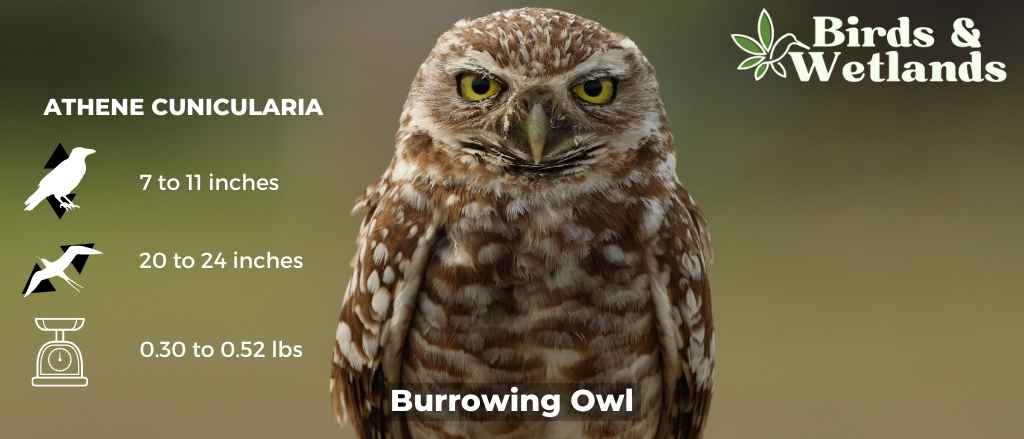
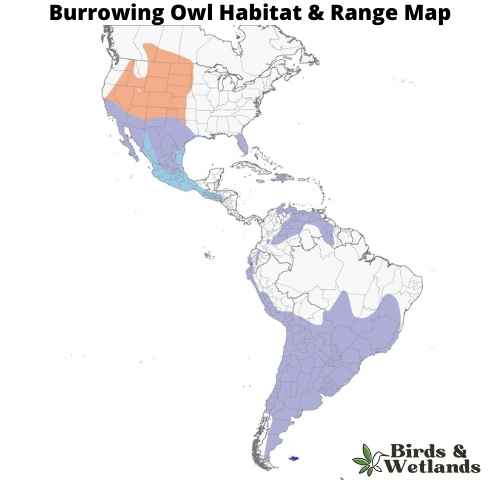
Burrowing Owl Sound
Scientific Name: Athene cunicularia
Length: 7–11 in
Wingspan: 20–24 in
Weight:5–8 oz
The Burrowing Owl is a small, long-legged species of owl found in North and South America. Known for its unusual habit of living in burrows in the ground.
Burrowing Owls have a rounded head with no ear tufts and bright yellow eyes. Their overall coloration is mottled brown and white with a distinct white “eyebrow” above each eye.
Their primary habitat includes open landscapes such as grasslands, deserts, agricultural areas, golf courses, and even airports. As their name suggests, these owls often reside in burrows, many of which are abandoned by prairie dogs, ground squirrels, or other burrowing animals. In some cases, they may also dig their own burrows.
Burrowing Owls diet consists mainly of small mammals and insects, but they also eat birds and reptiles.
Burrowing Owls have a unique nesting behavior. They lay their eggs in an underground burrow to protect them from predators and extreme weather. Clutch sizes range from 6 to 11 eggs, which are incubated for about a month before hatching.
Barred Owl (Strix varia)

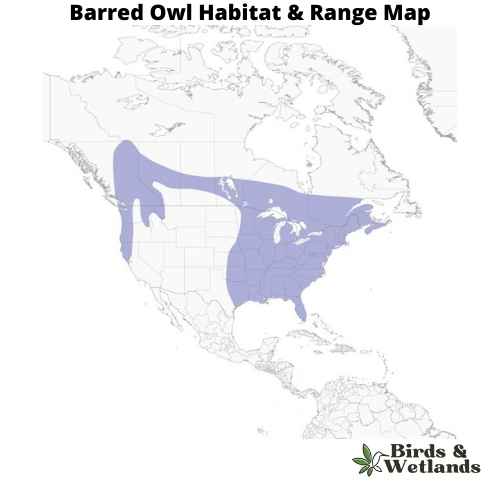
Barred Owl Sound
Scientific Name: Strix varia
Length: 40 to 63 cm (16 to 25 in)
Wingspan: 96 to 125 cm (38 to 49 in)
Weight: 468 to 1,150 g
The Barred Owl is a medium-sized owl with a barred pattern on its chest and belly. They have large yellow eyes that allow them to see well in low light conditions. Their ears are not very large which means they do not hear very well but they have excellent hearing abilities which allow them to detect sounds up to 1 mile away. Their feathers are brown and streaked with white, and they have black bars on their chests and wings.
Their habitats include forests, woodlands, orchards, parks, farmland and suburban backyards.
Barred Owls (also known as hoot owl) eat small mammals such as mice, rats and squirrels. They also eat insects such as beetles or grasshoppers. These owls hunt during the day when it is light out so that they can see their prey better than at night when they would be using senses other than sight like sound or smell to find their food source.
Barred owls are monogamous birds which means they mate for life. They build nests in trees or cavities on the ground and lay 2-4 eggs per year. The incubation period for these eggs lasts about 28 days before hatching takes place.
The long-eared owl (Asio otus)
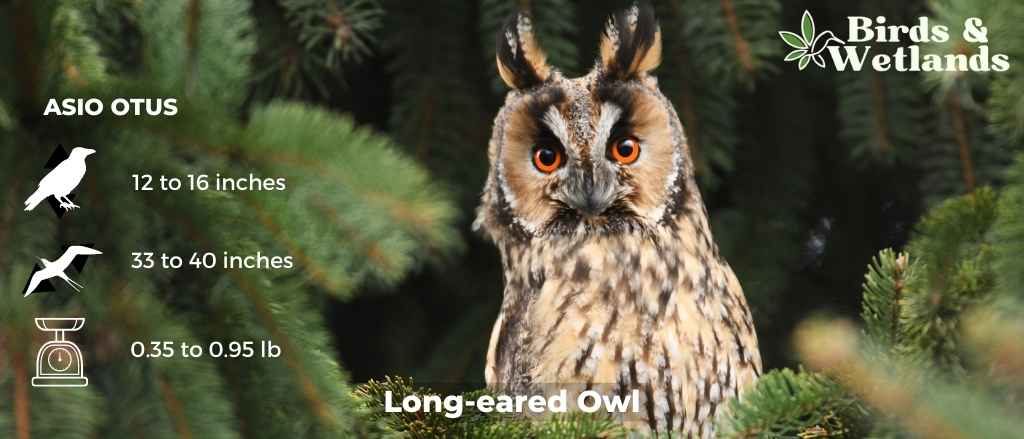
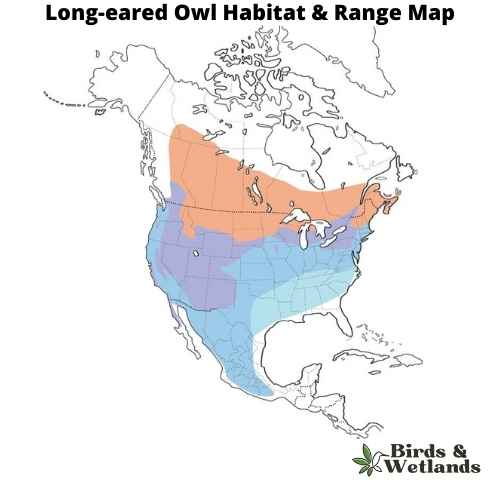
Long-eared Owl Sound
Scientific Name: Asio otus
Length: 12 and 16 in
Wingspan: 2 ft 10 in to 3 ft 4 in
Weight: 5.6 to 15.3 oz
The Long-eared Owl is a medium-sized owl species known for its distinctively long ear tufts, which can be raised or lowered depending on the bird’s mood or intention.
Long-eared Owls have mottled brown and cream plumage, which provides excellent camouflage among the trees. Their most distinctive features are their long, black-tipped ear tufts, which are set closer to the center of the head than in most other owl species.
These owls inhabit a wide variety of habitats, including deciduous and coniferous forests, woodlands, and even semi-deserts.
The Long-eared Owl’s diet primarily consists of small mammals, especially voles, but they will also take small birds and insects. They are skillful hunters, often capturing prey from a perch or in flight.
In terms of nesting behavior, Long-eared Owls do not construct their own nests, instead they take over old nests built by other bird species, usually those of corvids or other large birds. They lay an average of 4 to 5 eggs, which are incubated by the female while the male provides food.
Short-eared Owl (Asio flammeus)
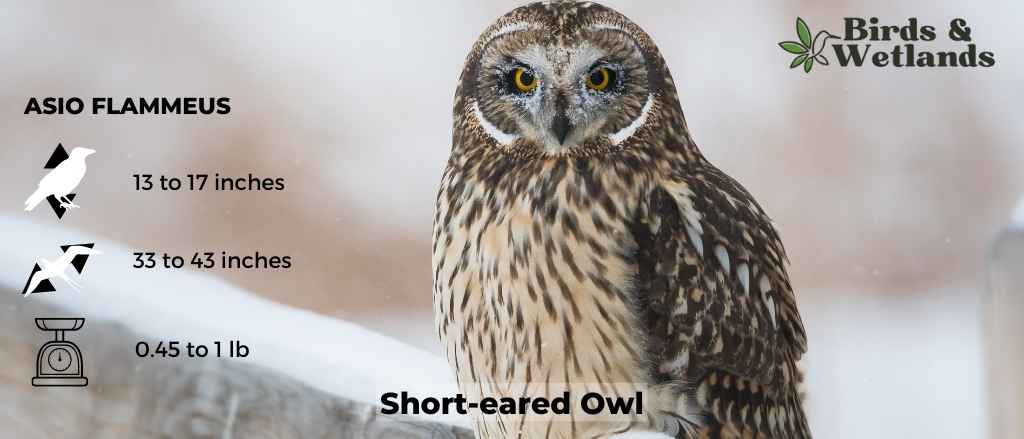
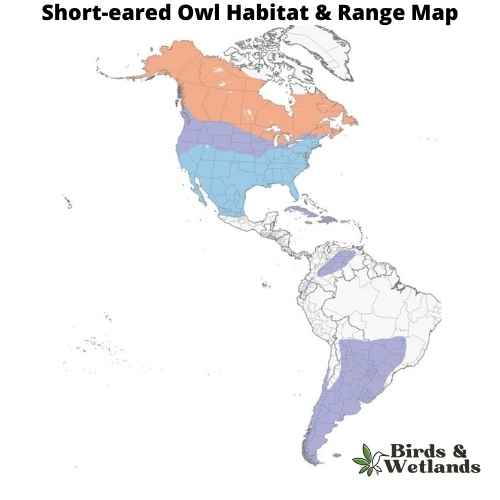
Short-eared Owl Sound
Scientific Name: Asio flammeus
Length: 13–17 in
Wingspan: 33 to 43 in
Weight: 7.3–16.8 oz
The Short-eared Owl is a medium-sized owl species with a wide distribution, found across North and South America, Europe, Asia, and many Pacific islands. Despite its name, the “ears” of the Short-eared Owl are not often visible, as they are small and tend to blend with the bird’s feathers.
The owls are predominantly brown with buff and white accents throughout their body and wings, and dark patches around their yellow eyes.
Short-eared Owls diet consists largely of small mammals, especially voles. However, they are opportunistic hunters and will also prey on a variety of other animals, including other birds, when available.
Their habitat is characterized by open areas like grasslands, marshes, and tundra. They nest on the ground, which is unusual for owls, and this makes them vulnerable to ground predators. As such, they often live in areas with tall grasses or other ground cover for protection.
Barn Owl (Tyto alba)

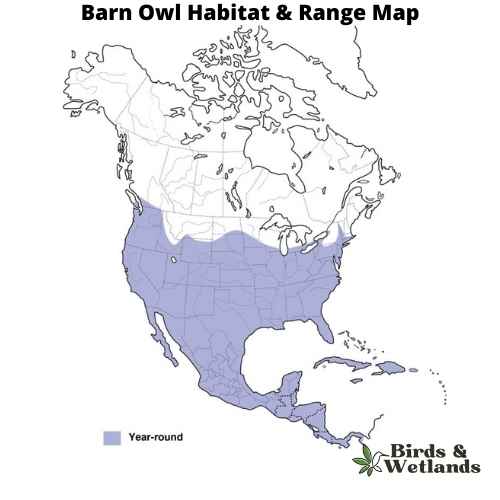
Barn Owl Sound
Scientific Name: Tyto alba
Length: 13 to 15 in
Wingspan: 31 to 37 in
Weight: 9.2 oz
The Barn Owl is a widespread species of owl known for its distinctive heart-shaped facial disc.
Barn Owls are medium-sized owls, they are pale overall with golden-brown wings and back, contrasted by a white face, chest, and belly. Their most notable feature is their heart-shaped facial disc, which helps channel sound to their ears.
Barn Owls are typically found in open habitats, including farmland, woodland, and marshes. They are named for their habit of nesting in human structures such as barns, church towers, and in the hollows of large trees. These owls are nocturnal, hunting at night and roosting during the day.
The diet of Barn Owls primarily consists of small mammals, particularly rodents such as mice and rats. They are known for their silent flight, which allows them to sneak up on their prey without detection.
Barn Owls have a unique nesting behavior. They do not build nests, but instead, lay their eggs directly on the bare surface of a secluded ledge or cavity. A female typically lays 4-7 eggs, and both parents help incubate the eggs and care for the chicks.
Boreal Owl (Aegolius funereus)
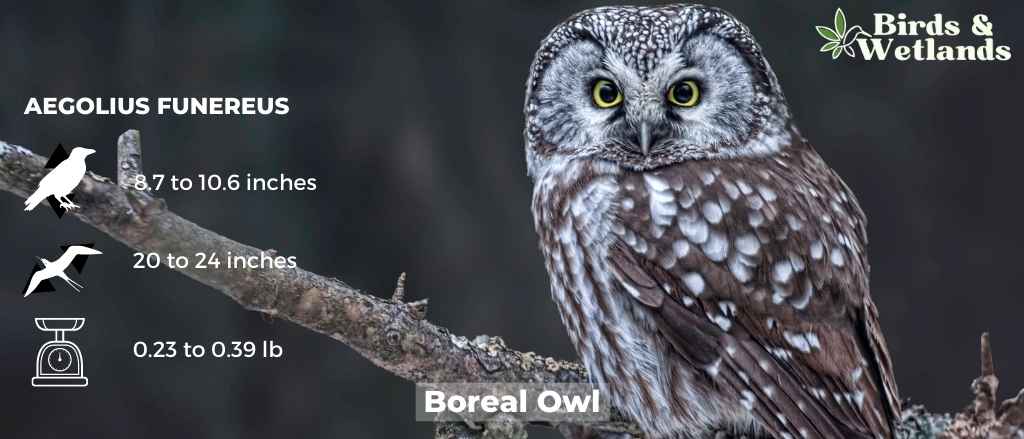
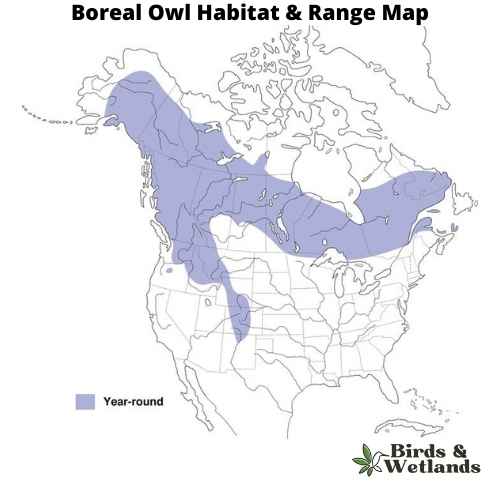
Boreal Owl Sound
Scientific Name: Aegolius funereus
Length: 8.7–10.6 in
Wingspan: 20–24 in
Weight: 3.8 oz–6.3 oz
The Boreal Owl, also known as Tengmalm’s Owl, is a small yet captivating nocturnal bird found predominantly in the northern hemisphere’s boreal forests, hence its name.
The Boreal Owl is petite in size, its plumage is predominantly grayish-brown, with white spots sprinkled on the upper parts and pale streaks on the underside, which lends a mottled effect. The bird’s rounded head, lack of ear tufts, and large yellow eyes are characteristic traits of this species.
Boreal Owls have a distinctive call, described as a series of soft, low hoots, which can often be heard during the cold winter months. As strictly nocturnal birds, they rest during the day, usually in tree cavities or similar concealed spots, and become active at night.
These owls are remarkable hunters, feeding mainly on small mammals such as voles and shrews, although they have been known to consume small birds when available. Their exceptional hearing allows them to locate prey under the snow in the darkest of nights.
Vultures
Vultures are the last birds of prey to be discussed in this article. They are scavengers and so their main diet is dead animals’ bodies. They do not have any hairs on their heads. This helps them to remain clean even when they poke their bodies into the bloody flesh of dead animals while eating.
Turkey Vulture (Cathartes aura)
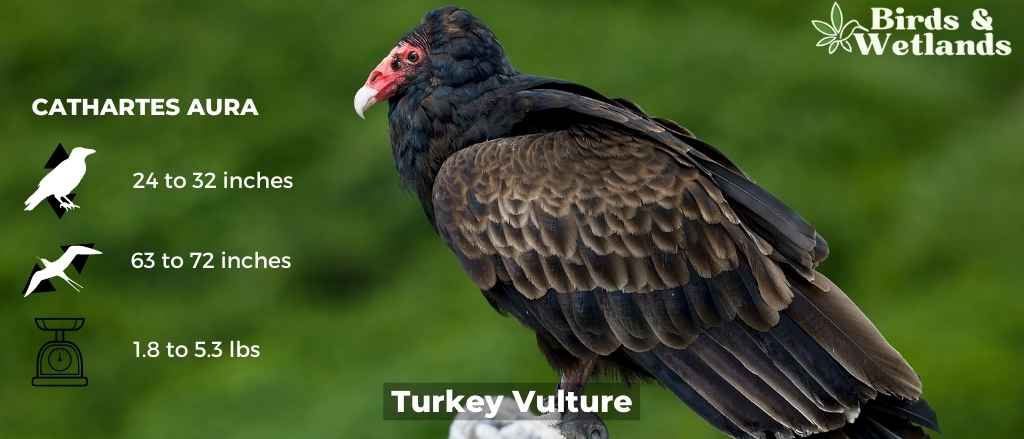
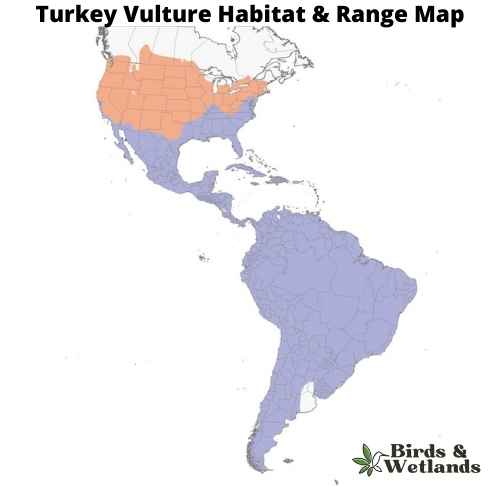
Turkey Vulture Sound
Scientific Name: Cathartes aura
Length: 24–32 in
Wingspan: 63–72 in
Weight: 1.8 to 5.3 lb
Turkey vultures are large birds that are easily recognizable by their bald heads, which are black in coloration, and by the patch of red skin below their beaks. It is white with black spots on the wings and tail. It has a bald head and a hooked beak that is black in coloration.
Turkey vultures live in the Americas, Europe, Africa, and Asia. They can be found in deserts, grasslands, forests and swamps. Turkey vultures are found throughout North America and parts of Central America and South America. In the U.S., they can be found across the country, but most commonly in the southwest region.
Turkey vultures eat carrion—dead animals’ remains such as dead deer, sheep, cows, horses and other large mammals that have been killed by other predators, such as coyotes or foxes. They do not hunt live prey.
The Black Vulture (Coragyps atratus)
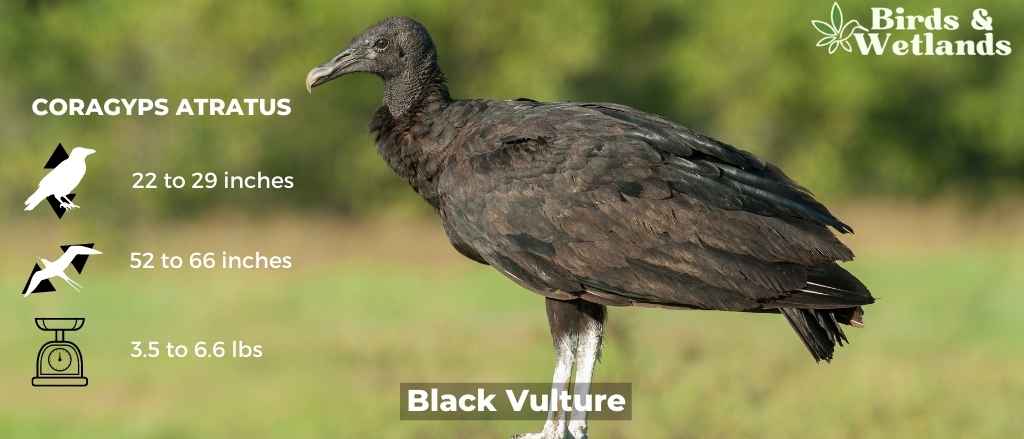

Black Vulture Sound
Scientific Name: Coragyps atratus
Length: 22–29 in
Wingspan: 52–66 in
Weight: 3.5 to 6.6 lb
The Black Vulture is easily recognizable by their black plumage, short, square tail, and their bald black head.
These birds are scavengers and play a vital role in the ecosystem by feeding primarily on carrion (dead animals). They are known to occasionally kill smaller, weakened animals, but such behavior is not the norm. Black Vultures locate food using their excellent sense of sight and by following other vultures.
Unlike most birds, Black Vultures are not known to build traditional nests. Instead, they lay their eggs in sheltered areas like hollow trees, abandoned buildings, or thickets. They typically lay two eggs, and both parents will incubate and care for the chicks.
Black Vultures are social birds that are often seen in large groups. They roost together in large numbers and are known to even forage in groups. They can often be seen soaring on thermals during the day, hardly flapping their wings, while looking for food.
California Condor (Gymnogyps californianus)


Scientific Name: Gymnogyps californianus
Length: 46-53 in
Wingspan: 9.8 ft
Weight: 26 lb
The California condor is one of the largest land birds in North America.
California condors are large black vultures with white heads, necks, and underbellies. Their feathers have dark tips and shafts, giving them a mottled look when viewed from a distance. They have a bald red head with a black eye patch and a white base of their bill which gives them an “old man” look.
They live in temperate forests along mountain ranges where there are large trees for roosting at night. They can also be found near water sources like rivers or lakes because they need water to drink as well as bathe themselves regularly.
They are scavengers that feed on dead animals such as carrion (dead bodies), carcasses, and garbage. They also eat live animals such as rabbits and small rodents but this is rare because they only need to eat once every couple of days at most.
They prefer open land with cliffs or rocky areas for nesting. The birds feed on carrion—dead animals that have already been killed by other predators or humans—and sometimes small animals such as mice and rabbits if necessary. California Condors build large nests out of sticks high up on cliffsides or sometimes in trees. They lay one egg every other year and incubate it for two months before hatching happens. The young condors will spend five months learning how to fly before they leave their parents’ territory around eight months old (older ones might stay longer).
Where to Find Birds of Prey in the US
1. Everglades National Park, Florida: With its rich and diverse ecosystem, the Everglades National Park is a haven for a variety of Birds of Prey. The vast wetlands and prairies provide an ideal habitat for species like the Bald Eagle, Osprey, Northern Harrier, and the rare Swallow-Tailed Kite. Bird-watchers can embark on guided tours or explore the park’s trails to spot these majestic creatures.
2. Hawk Mountain Sanctuary, Pennsylvania: This is one of the premier places to watch hawks in America. Located on the Appalachian flyway, the sanctuary witnesses the annual migration of a plethora of hawk species, such as the Broad-winged Hawk, Red-Tailed Hawk, and the Sharp-Shinned Hawk. With over 18,000 acres of protected land, the sanctuary offers an unrivaled bird-watching experience with breathtaking vistas.
3. San Juan Islands, Washington: The San Juan Islands are a notable habitat for the Bald Eagle, with one of the highest densities of this majestic bird in the continental United States. Bird watchers can also spot the Peregrine Falcon and several species of hawks and owls in this stunning Pacific Northwest archipelago.
4. Bosque del Apache National Wildlife Refuge, New Mexico: This refuge is renowned for its large populations of birds, including several Birds of Prey. It is a hotspot for raptors such as the Bald Eagle, Golden Eagle, Red-Tailed Hawk, and the Ferruginous Hawk. Each winter, the refuge hosts the “Festival of the Cranes,” attracting bird enthusiasts from across the globe.
5. Denali National Park, Alaska: Denali National Park is home to an array of Birds of Prey, including the Golden Eagle and the Great Horned Owl. This rugged wilderness provides an exceptional bird-watching experience, with birds easily spotted against the vast, open landscapes. Its diverse habitats make it a preferred nesting ground for a variety of raptors.
Each of these locations offers unique opportunities to observe America’s Birds of Prey in their natural habitats, providing unforgettable experiences for any bird-watcher.
Northeast:
| State | Birds of Prey |
|---|---|
| Connecticut | Birds of Prey in Connecticut |
| Delaware | Birds of Prey in Delaware |
| Maine | Birds of Prey in Maine |
| Maryland | Birds of Prey in Maryland |
| Massachusetts | Birds of Prey in Massachusetts |
| New Hampshire | Birds of Prey in New Hampshire |
| New Jersey | Birds of Prey in New Jersey |
| New York | Birds of Prey in New York |
| Pennsylvania | Birds of Prey in Pennsylvania |
| Rhode Island | Birds of Prey in Rhode Island |
| Vermont | Birds of Prey in Vermont |
Midwest:
| State | Birds of Prey |
|---|---|
| Illinois | Birds of Prey in Illinois |
| Indiana | Birds of Prey in Indiana |
| Iowa | Birds of Prey in Iowa |
| Kansas | Birds of Prey in Kansas |
| Michigan | Birds of Prey in Michigan |
| Minnesota | Birds of Prey in Minnesota |
| Missouri | Birds of Prey in Missouri |
| Nebraska | Birds of Prey in Nebraska |
| North Dakota | Birds of Prey in North Dakota |
| South Dakota | Birds of Prey in South Dakota |
| Ohio | Birds of Prey in Ohio |
| Wisconsin | Birds of Prey in Wisconsin |
South:
| Alabama | Birds of Prey in Alabama |
| Arkansas | Birds of Prey in Arkansas |
| Florida | Birds of Prey in Florida |
| Georgia | Birds of Prey in Georgia |
| Kentucky | Birds of Prey in Kentucky |
| Louisiana | Birds of Prey in Louisiana |
| Mississippi | Birds of Prey in Mississippi |
| North Carolina | Birds of Prey in North Carolina |
| Oklahoma | Birds of Prey in Oklahoma |
| South Carolina | Birds of Prey in South Carolina |
| Tennessee | Birds of Prey in Tennessee |
| Texas | Birds of Prey in Texas |
| Virginia | Birds of Prey in Virginia |
| West Virginia | Birds of Prey in West Virginia |
West:
| Alaska | Birds of Prey in Alaska |
| Arizona | Birds of Prey in Arizona |
| California | Birds of Prey in California |
| Colorado | Birds of Prey in Colorado |
| Hawaii | Birds of Prey in Hawaii |
| Idaho | Birds of Prey in Idaho |
| Montana | Birds of Prey in Montana |
| Nevada | Birds of Prey in Nevada |
| New Mexico | Birds of Prey in New Mexico |
| Oregon | Birds of Prey in Oregon |
| Utah | Birds of Prey in Utah |
| Washington | Birds of Prey in Washington |
| Wyoming | Birds of Prey in Wyoming |
FAQs About Birds of Prey in America
What is the most common bird of prey in North America?
The most common bird of prey in North America is the red-tailed hawk. These birds can be found all across the continent, and are known for their characteristic red tail feathers.
Red-tailed hawks typically eat small mammals such as rodents or birds. However, they will also eat reptiles, amphibians, and insects.
What are some predatory birds?
Predatory birds are birds that hunt and eat other animals. Some of the most common predatory birds in North America include hawks, eagles, and owls.
These birds are known for their keen eyesight and hunting skills. They typically eat small mammals such as rodents or rabbits. However, they will also eat reptiles, amphibians, and insects.
New World vultures are also considered predatory birds, although they do not hunt live animals. Instead, they feed on the carcasses of dead animals. Vultures help to keep the environment clean by eating carcasses that would otherwise decay and release harmful bacteria into the air.
Do all birds of prey eat meat?
Yes, all birds of prey are carnivores and eat meat. Hawks, eagles, and owls typically eat small mammals such as rodents or birds. However, they will also eat reptiles, amphibians, and insects.
What is the best time of year to see Birds of Prey in America?
Birds of Prey can be observed throughout the year, but the best period is during migration seasons—spring (March to May) and fall (September to November). During these times, diverse species are on the move, offering prime viewing opportunities.
What kind of equipment do I need for bird watching?
A good pair of binoculars is crucial for bird watching, providing the necessary zoom to observe Birds of Prey up close. Field guides and apps can also help identify species. Comfortable clothing and sturdy shoes are essential for long hours in the field.
Are Birds of Prey endangered in America?
Some Birds of Prey species are indeed endangered in the U.S., including the California Condor and the Northern Spotted Owl. Conservation efforts are underway to protect and bolster these populations. Always observe birds respectfully to avoid disturbance.
What should I do if I find an injured Bird of Prey?
If you encounter an injured Bird of Prey, do not attempt to handle it yourself. These are wild creatures that can be dangerous when threatened. Instead, contact a local wildlife rehabilitation center or animal control for assistance.

